Committee Blog: Cannabis and Cardiovascular Disease

Is Cannabis safe for your heart? Here’s what we know so far.
As cannabis use expands in the U.S, investigating its effects on health is more important than ever. Recently, studies have raised important questions about cannabis’ impact on heart health. Can cannabis contribute to heart disease, stroke, or other cardiovascular problems? And how can people use it safely?
What research suggests
Over the past few years, a pattern has been catching researchers’ attention, studies suggest that people who use cannabis, especially regularly or heavily, might be facing a higher risk of heart-related problems.
In 2025, a meta-analysis of 24 studies reported that cannabis users had about a 29% higher chance of having serious cardiovascular events like heart attacks or strokes. That doesn’t mean cannabis directly causes these problems, science rarely works in absolutes, but it’s a signal we can’t ignore.
A 2024 study in the Journal of the American Heart Association took a closer look at survey data from across the U.S. and found a clear trend: the more days per month someone used cannabis, the higher their risk of heart issues. Heavier use seemed to carry a heavier risk.
Then, one of the largest retrospective studies to date analyzed the medical records of over 4.6 million people, all under age 50, following them over three years. They found that cannabis users had a sixfold increase in heart attack, a fourfold increase in ischemic stroke, a twofold increase in heart failure, and a threefold increase in cardiovascular death, compared to non-users. In 2025, a study in JACC Advances found similar links between cannabis use and acute heart problems, with younger users appearing especially at risk.
In another study from UCSF, researchers looked at 55 healthy cannabis users, some who smoked and others who used edibles, and compared them to non-users. They measured something called vascular function, how well the blood vessels can relax and expand. That ability is crucial for regulating blood flow and blood pressure, and when it’s impaired, it’s an early sign that the cardiovascular system may be under stress. This study showed that vascular function in cannabis users was about half that of nonusers. And here’s what’s really interesting, only the smokers showed harmful changes in blood markers related to inflammation and blood vessel injury. That suggests that smoking adds a layer of risk beyond THC itself.
These findings suggest that cannabis use, especially frequent or higher-dose use, might be associated with increased risk of cardiovascular events or vascular dysfunction.
Cannabinoids and the heart
Our bodies make their own cannabinoids, chemicals that help control things like inflammation, blood pressure, and how blood vessels behave. Cannabis interacts with that system, especially THC, the substance that causes the “high”. It can make the heart beat faster and the blood pressure go up. That pushes the heart to work harder, which may be a problem if someone already has narrowed arteries or other conditions. It can also cause blood vessels to tighten, which might reduce flow in sensitive areas like the heart or brain. Over time, THC may trigger inflammation and damage in the vessels.
CBD on the other hand, doesn’t bind to the same receptors as THC and may even help with relaxing vessels or lowering inflammation according to some lab studies. But we don’t know yet if it has the same effect in humans.
We know even less about other minor cannabinoids and terpenes, the aromatic compounds that give the plant its scent. These chemicals might have their own effects on the heart and blood vessels, but the science on that is still in its early days.
The key thing to understand is that cannabis isn’t just one drug. It’s a mix of different active compounds and they don’t all work the same way. Some may affect the cardiovascular system more than others, and possibly in opposite directions.
What we don’t know
Let’s talk for a minute about what this research does not actually show. In science, it is just as important to know the limits of the evidence as it is to focus on the results.
Right now, most of what we know about cannabis and heart health comes from what’s called observational studies. That means researchers are looking at people’s real-life behavior and health without trying to control who uses cannabis or how much they use, just observing people’s choices and outcomes. These studies are especially important for discovering associations and patterns to help researchers decide where to look more closely next.
They help us see when certain exposures, like cannabis use, tend to show up more often alongside specific health outcomes, like heart disease or stroke.
So, observational studies can tell us if two things tend to go together, but not if one is causing the other.
Other factors, like diet, exercise, stress levels, or even use of other substances, might be driving some of the risk we see. Additionally, most of the data we have so far comes from younger adults, so we don’t yet know what these risks look like in older adults or in people who already have cardiovascular disease, who might be most vulnerable.
Clinical trials are usually the gold standard to obtain evidence of cause and effect when testing new treatments before being launched to market. For cannabis, running large clinical trials is tough when regulations get in the way. Another thing to consider is that cannabis is already being used every day, in so many different forms, that a tightly controlled trial often can’t capture real-world patterns very well. In that sense, studies more similar to “phase 4” drug research, which track safety and effectiveness once a product is already in use, may be more appropriate for understanding cannabis.
Real-World Cannabis use and heart health
One of the biggest roadblocks in cannabis and heart research is knowing what people are using. Most studies rely on patients’ self-reported cannabis use and broad categories, like “ever used” or “used in the past 30 days.” That leaves out important details like how much THC someone used, how often, in what form, and how their habits changed over time.
Cannabis dispensaries already track a lot of this information through point-of-sale systems. Every purchase comes with a record of product type, THC, CBD, and other cannabinoids content, how much was bought, and when. If researchers could securely and ethically link that purchase data with patients’ health records, while protecting privacy, we could finally answer questions that so far have been out of reach: How does risk increase with higher doses or stronger products? Are edibles safer than smoking? Is there a threshold where risk starts to climb? Could we even monitor which strains or product lots are tied to more side effects?
This kind of approach could remove one of the biggest blind spots in cannabis research, bringing us closer to giving people real, practical guidance based on how cannabis is used in the real world.
Management Science Associates, a data analysis company based in Pittsburgh, has been working on this. Since 2017, they’ve been collecting and analyzing cannabis sales data from several states, linking product details with health data. This approach could enable researchers to produce studies precise enough to understand cannabis risks and safety and provide clear health and policy guidance.
The team used this very approach in a study to explore how real-world cannabis use relates to heart health, linking cannabis purchase data with electronic health records. The study included over 3,200 adults, compared cannabis users with non-users, and looked at both younger adults (ages 20–39) and older adults (ages 40–79).
Here’s what this study found:
- In older adults, cannabis use did not raise the 10-year risk of cardiovascular disease. Age, diabetes, and being male were much stronger predictors of risk than cannabis itself.
- In younger adults, cannabis use was linked to higher odds of being in the high-risk group for lifetime cardiovascular disease. Higher body weight also played a role.
- When examining risk markers, cannabis users tended to have slightly lower blood pressure, a lower LDL, often labeled “bad” cholesterol, and higher HDL, commonly referred to as “good” cholesterol.
That might seem like a protective effect, but it’s important to remember that LDL and HDL are no longer viewed as entirely “good” or “bad” in isolation. Research suggests it’s the quality and function of these lipoproteins, not just how high or low their levels are, that matter most for cardiovascular risk.
- Younger patients were consuming products with higher THC percentage than patients in the older group.
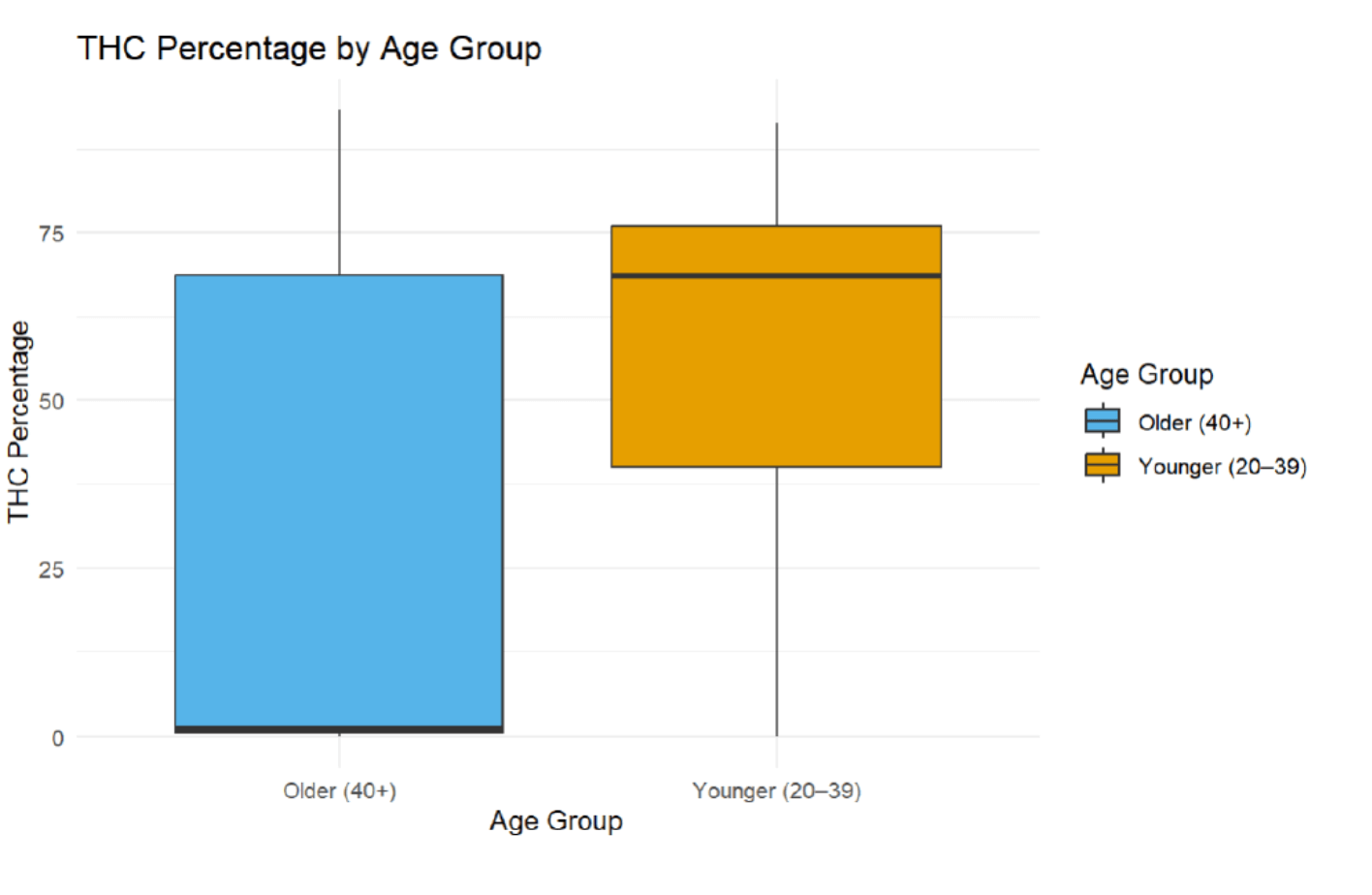
- Edibles and capsules looked safer in older adults, while vapes stood out as riskier across both age groups.
- THC and CBD seemed to pull in different directions. Higher THC levels were tied to higher cardiovascular risk, while higher CBD levels leaned toward lower risk.
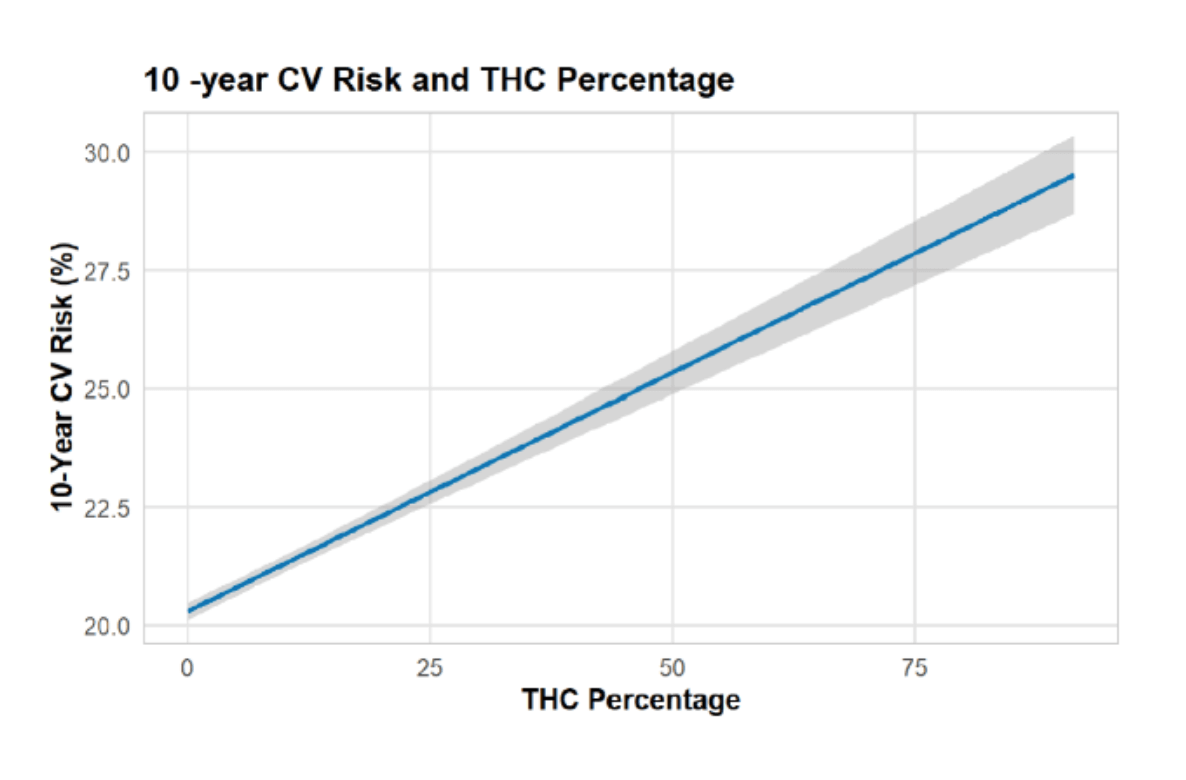

These results suggest cannabis has a complex relationship with heart health. For older adults, it may not increase near-term risk, but in younger adults, it could add to long-term concerns, and the type of product, along with the balance between THC and CBD, seems to matter.
Bottom Line
The research we have right now is enough to raise concerns, but not enough to draw firm conclusions. They should prompt thoughtful decisions, further research, and open conversations.
What To Do Now?
For patients and everyday users:
– If you use cannabis, tell your doctor what kind, how often, by what method, and how strong it seems to be. That information helps doctors better monitor your heart health.
– The pattern we see in the research is that more frequent and heavier use seems to carry more risk. It suggests that less is safer.
– How you take cannabis matters. Smoking brings added harm (carbon monoxide, fine particles). Edibles or vaping might reduce inhalation damage, but THC’s effects on the blood vessels still apply. If you smoke tobacco too, quitting or reducing it is one of the most powerful things you can do for your heart.
– Don’t ignore warning signs. Chest pain, rapid heartbeats, sudden weakness, slurred speech, or trouble breathing aren’t things to wait on. Get medical help.
For clinicians and healthcare:
– Ask patients about cannabis use as part of cardiovascular risk assessment. Document form, frequency, and estimated potency when possible.
– Stay alert to changes in cardiovascular symptoms in patients using cannabis.
– Promote and participate in research, registries, and data linkage projects.
For cannabis industry and policymakers:
– Encourage clear labeling (THC/CBD content), dosing guidance, and consumer education.
– Support partnerships to link retail sales data with health outcomes, with rigorous privacy and ethical safeguards.
– Avoid marketing ultra-potent formulations without safety data.
– Fund high-quality cardiovascular studies of cannabis use.
– Monitor trends in cannabis use and cardiovascular disease incidence in legalized jurisdictions.
Innovation in CBD Gummies: Vegan, Custom-Dose, Functional Blends

A few years ago, picking a CBD gummy was simple—grab the fruitiest one on the shelf and hope it worked. But as users got smarter, so did the products. People started asking, What’s actually in this? How much CBD do I really need? And can it do more than just help me relax?
That curiosity is driving a quiet revolution in the CBD gummy world. We’re seeing cleaner formulas, precise dosing, and wellness stacks that combine CBD with adaptogens, minor cannabinoids, and smarter absorption tech. It’s no longer about just having a gummy—it’s about choosing one that fits how you live and what your body needs.
Let’s walk through the innovations behind this new generation of CBD gummies—and what they mean for both consumers and the cannabis industry.
A New Generation of CBD Gummies Is Emerging
CBD gummies aren’t just sweet treats with mystery ingredients anymore. Today’s users want more: cleaner labels, reliable effects, and benefits tailored to real-life needs.
That’s pushing real innovation. Brands are rethinking how they source, formulate, and deliver their products. The result? CBD gummies that are vegan, gluten-free, organically grown, and third-party tested; not as extras, but as standard features.
Even more, there’s a shift toward purpose-built edibles. It’s not just about how many milligrams you’re taking, but why. What’s the function? What’s the goal?
This new wave is reshaping consumer expectations and raising the bar for the cannabis industry.
Vegan Formulations Are Now the Standard, Not the Exception
It wasn’t long ago that buying CBD gummies meant flipping the label, spotting gelatin, and walking away. For vegans, or anyone avoiding animal byproducts, options were slim and rarely satisfying.
That’s no longer the case.
Today, vegan CBD gummies are the default in many product lines. Brands are using fruit-based pectin, skipping artificial dyes, and sweetening with natural alternatives. Not because it’s a trend—but because consumers asked for better.
This shift isn’t about niche appeal anymore. It’s about making CBD accessible, no matter your diet or lifestyle.
The shift has also pushed the industry toward cleaner, more thoughtful ingredient lists. Now, when you pick up a pack of CBD gummies, there’s a good chance it checks off more than just the “plant-based” box.
And honestly, that’s a good sign—not just for consumers, but for the industry as a whole.
Custom-Dose Options Are Giving Users More Control
Not everyone needs the same amount of CBD and the industry has finally caught up to that.
For a long time, most CBD gummies came in standard doses: 10mg, maybe 25mg. But now, brands are offering more precise options. Some start as low as 2.5mg for those who are new or simply want a light effect. Others go up to 50mg or more for users with higher needs—like pain, sleep, or deeper relaxation.
This shift gives people the ability to adjust based on the day. Need less during the workweek? Take a lower dose. Want stronger support after a tough workout? Take a little more.
A few products even include multiple strengths in the same pack, so users can experiment and find what actually works for them—instead of guessing.
These changes aren’t just about convenience. They reflect a deeper shift: treating CBD like a personal routine, not a generic solution.
Functional Blends: CBD + Botanicals + Minor Cannabinoids
CBD alone is no longer the full story—and honestly, it never was. Today’s top gummies are combining CBD with other natural compounds to create formulas with a purpose.
Think CBD + CBN for sleep. CBD + ashwagandha for stress. CBD + turmeric for inflammation. These aren’t just feel-good combos—they’re targeted blends built on research-backed synergies.
Minor cannabinoids like CBG, CBN, and CBC are showing up more often too. They’re not just filler; each has unique effects that can support mood, focus, or physical recovery in ways CBD can’t do alone.
Add in functional botanicals—like chamomile, valerian root, or even green tea extract—and the result is a more customized experience, without synthetic ingredients or guesswork.
This is where the industry is headed: precision over general wellness, and formulas designed to actually support how you live, work, and recover.
What This Innovation Means for the Cannabis Industry
All these shifts, vegan formulas, custom dosing, and functional blends aren’t just consumer wins. They’re setting new benchmarks for the entire cannabis market.
It’s no longer enough to offer a basic CBD gummy. Brands are now expected to deliver transparency, purpose-driven formulations, and real results.
This demand is pushing manufacturers to invest in better extraction methods, smarter delivery systems, and more precise R&D. It’s also opening doors for cross-industry partnerships with wellness, nutrition, and even pharmaceutical sectors.
In short? The bar is higher and that’s a good thing.
Conclusion
CBD gummies aren’t what they used to be, and that’s a good thing.
What started as a simple chewable has grown into a category full of thoughtful design: plant-based formulas, precise dosing, and blends that actually serve a purpose. It’s less about jumping on trends and more about meeting people where they are: whether they’re managing stress, supporting sleep, or just looking for something clean and consistent.
This shift tells us a lot about where cannabis is headed. It’s growing up. And the more the products evolve, the more trust they earn.
Committee Blog: The Digital Dollar Dilemma – How a U.S. CBDC Could Reshape Cannabis Banking

Published by NCIA’s Banking & Financial Services Committee (BFSC)
Executive Summary
A potential U.S. Central Bank Digital Currency (CBDC) represents one of the most disruptive technologies on the horizon for the financial world, with profound implications for the cannabis industry. While a “digital dollar” could theoretically solve the industry’s payment rail issues overnight, it also introduces significant threats related to privacy, data security, and direct federal oversight, creating a high-stakes dilemma for cannabis businesses and the institutions that bank them. However, recent developments have fundamentally altered this landscape, particularly the January 2025 Executive Order 14178 halting U.S. CBDC development and ongoing progress with cannabis banking legislation.
Current State Analysis
The conversation around a U.S. CBDC has evolved dramatically from academic theory to active research, most notably through the Federal Reserve’s collaboration with MIT on “Project Hamilton,” which completed its Phase 1 research in February 2022. However, in January 2025, President Trump issued Executive Order 14178, explicitly prohibiting federal agencies from “undertaking any action to establish, issue, or promote a CBDC” and revoking previous digital asset policies. This makes the United States the only major economy to halt CBDC development through executive action. Despite this policy shift, understanding the potential impacts of CBDCs remains relevant, as policy positions can change with administrations, and other countries continue rapid CBDC development that could influence global financial systems. For the cannabis industry, banking challenges persist despite the executive order. The core issue remains the industry’s reliance on private-sector workarounds. Fintechs and banks have invested heavily in BSA/AML programs to manage the risks of handling cash deposits.
Legislative Developments
Simultaneously, significant progress has occurred with cannabis banking legislation. The SAFE Banking Act evolved into the SAFER Banking Act (S.2860), which passed the Senate Banking Committee with a bipartisan 14-9 vote and awaits a Senate floor vote. This legislation would provide safe harbor protections to financial institutions serving state-legal cannabis businesses, potentially resolving many banking challenges independent of any CBDC considerations. Additionally, cannabis rescheduling efforts at the federal level could fundamentally alter banking access. While rescheduling alone wouldn’t resolve all banking issues, it would reduce regulatory burden and risk perception for financial institutions considering cannabis banking services.
Regulatory Landscape
The introduction of a CBDC, if policy were to reverse, would create a direct and unavoidable conflict with the Controlled Substances Act (CSA). Every transaction involving a CBDC would be recorded on a central ledger managed by the Federal Reserve, raising critical policy questions about privacy versus surveillance. The Federal Reserve’s previous white papers presented various models, from anonymous, token-based systems (similar to cash) to account-based systems that would link every transaction to a verified identity. If the U.S. were to adopt an identity-based CBDC in the future, the federal government would have a real- time, unalterable record of every dollar spent at every state-licensed dispensary in the country.
Alternative Pathways
With CBDC development currently halted, the cannabis industry must focus on alternative pathways to banking normalization:
1. Legislative Solutions: Continued advocacy for the SAFER Banking Act and similar legislation that would enable traditional banking services.
2. Existing Compliance Frameworks: Further investment in robust compliance programs under current FinCEN guidance, which remains relevant despite policy shifts.
3. Private Sector Innovation: Development of alternative payment solutions that can operate within current regulatory frameworks.
4. State-Level Banking Solutions: Some states are exploring state-chartered banking options specifically for cannabis businesses.
Key Takeaways
• The January 2025 Executive Order significantly altered the U.S. CBDC landscape but hasn’t resolved cannabis banking challenges
• The SAFER Banking Act represents the most immediate potential solution for cannabis banking issues
• Banks should continue investing in current compliance technologies rather than waiting for CBDC or legislative solutions
• The cannabis industry must actively engage with multiple parallel policy debates that impact banking access
• Privacy concerns remain central to any digital payment solution for the cannabis industry, whether government or privately issued
• Cannabis rescheduling efforts represent another potential pathway to improved banking access independent of payment technology development
How to Make the Most Out of Lobby Days

Dr. Amanda Reiman in conversation with Jeremy Marsh, from the Office of Congresswoman Dina Titus
NCIA’s 13th annual Cannabis Industry Lobby Days is rapidly approaching and new and seasoned attendees alike may be wondering how to make the most out of the precious time with electeds’ offices. Meeting with allies and skeptics both present unique challenges and opportunities. To provide advice on how to make the most out of Lobby Days, I reached out to Congresswoman Dina Titus’ office and spoke with Legislative Assistant Jeremy Marsh. Following his advice will help you walk away from Lobby Days feeling accomplished and confident that your message got through.
Stories from the community matter
White papers and data points are fine, but what really moves the needle are stories from the community and the front lines. Tailoring stories to the district/state of the office you are meeting with shows how constituents and local businesses are impacted by policy. These stories are great tools for supportive legislators to take to the floor and their committees. And, when meeting with a legislative office that has supported cannabis in the past, be sure to thank them! Standing up for cannabis is still a risk and those willing to take it should be acknowledged.
Rescheduling and hemp are still areas of confusion
Elected officials are more cannabis savvy now than ever before, but there are still some issues where education is needed. Don’t assume that elected officials, even supporters of cannabis are experts in all of the hot button issues being discussed in the industry. Mr. Marsh explains that rescheduling/descheduling and hemp regulation are two areas where confusion persists. Explain the issue before asking for support, and have some fact sheets ready with background information, as well be willing to answer questions and give context to these issues. Be sure you yourself can clearly explain the issues you are bringing into your Lobby Days visits.
Be early and be flexible
If you’re early you’re on time, if you’re on time, you’re late. This adage was drilled into my head by my Dad (thanks Dad!) and it is a great rule of thumb for Lobby Days. Try to be at least 5 minutes early to each meeting. Time is precious and being early shows that you are taking the process seriously. It also gives you time to collect your thoughts and your breath before heading into a meeting. Lines to get into the Capitol can be long, so keep this in mind before your first meeting of the day. If you are going to be late to a meeting, call the office and let them know. At the same time, be flexible. Schedules are constantly shifting for elected officials, so don’t take it personally if you are meeting with a staffer, or in the hallway outside the office. ALL communication is important, and many vital conversations happen outside the office doors (just watch Veep!).
The economy and public safety are selling points for opponents
Many would argue that meeting with opponents is just as, if not more, valuable than meeting with allies. And although cannabis has gained support from both sides of the aisle over the years, many are still skeptical of changing the laws around cannabis. If you meet with someone who has not traditionally been supportive, discussing the economic and public safety benefits of legalization is a good focus. Cannabis tax revenue has been used to support schools, roads, substance abuse programs, job placement and more. And, research shows that, after legalization, fewer teens are using cannabis, and fewer people are using opiates. You don’t have to be a fan of cannabis to be a fan of legalization.
NCIA’s 13th annual Cannabis Industry Lobby Days is a chance to bring the cannabis issue front and center with lawmakers. Once a source of snickers and jokes, the cannabis movement has become a major political force. Even so, assumptions about those involved in cannabis persist. Being prepared, professional and well versed on the issues will make an impression. And being a part of shedding a positive light on this industry and the people who work in it feels really great.
Member Blog: The Cannabis Crisis Plan – Business Insurance for the Future

Is Your Cannabis Business Prepared for the Unexpected?
In an industry as scrutinized as cannabis, a crisis can escalate quickly—having a solid plan in place can make all the difference.
Given its unusual balance between federal illegality and regional legality, the cannabis industry sometimes feels like it’s under a microscope. Indeed, because of this microscope, a cannabis crisis can blow up fast. From product recalls to regulatory and legal issues, the Avaans Media team has worked with cannabis companies – and non-cannabis companies – can face in moments of crisis. No crisis is ever “planned.” Because the very nature of a crisis is that it creeps up when you least expect it. Think it can’t happen to you? Seventy-nine percent of companies will experience a crisis with service disruption and media implications.
A moment of crisis doesn’t even have to be the brand’s fault. Many companies have gotten caught up in social media rumors, it could have to do with police, government officials or product recalls and yet in those cases, it is the company’s crisis to handle.
A crisis plan can be the unsung hero of an emergency. Putting a crisis plan in place may seem tedious, but a cannabis crisis is high stakes, and understanding when, who and how your company will handle a moment could save you millions in legal and PR fees, while also preserving the valuation of the brand, and the reputation in the eyes of customers, regulators, and the media. Crisis PR professionals can assess a situation quickly and guide you through this process. And a crisis plan will help you in those early critical moments. Tabletop exercises and media training are the muscle behind a crisis response.
Yet, if you find yourself in a crisis without a plan in place, there are three strategies to employ in a crisis.
Follow the traditional process of response.
We see this played out repeatedly, the traditional response to a crisis is to address the facts publicly, acknowledge the concern and the problem, apologize, and rectify. This is a well-worn process, and the media are all very familiar with this process.
It’s important with this strategy to consider the methods of response and that the urgency matches the level of the crisis. Spokesperson, media format, and timing are essential elements in this strategy.
What level of response does this moment demand? If the problem hasn’t hit the media, but your customers are upset, how will you deal with that differently than if the media is calling?
The truth is always your north star. That’s particularly true during tumult. Tell the truth, stick to the facts. If you don’t know the answer, it’s perfectly OK to say you don’t know and will return with an answer when you have one. Don’t make promises you aren’t sure you can keep.
Where and how you issue a statement is a message. Who issues the statement? Will you issue a statement on YouTube or on Instagram. Both? Will you talk to the media at a press conference, or will you issue a written statement to the media?
Use the Crisis to Effect Change
Sometimes, a crisis can be used as an opportunity. No doubt, this is a risky choice and should be taken with sincere consideration and expertise about when and how to share the story.
High Seas Dispensary in Costa Mesa, California did this recently when they ran into a sudden brick wall with city leaders who were withholding their city business permit. This came a surprise to the founders of High Seas Dispensary who had always been reputable players in California cannabis.
News coverage of the situation soon started bubbling up and the withholding was rescinded, allowing the dispensary to finally open its doors, albeit months later than planned.
The pre-opening crisis created an early interest with cannabis media, and it helped secure coverage of its opening.
Let The “Crisis” Die
This may be the riskiest choice of all. Because response is critical if a crisis has or will reach the media level. The first step in a crisis is to decide if it is an actual crisis and if so, what response there should be.
Indeed, some low-level crises feel stressful in the moment, but the reality is that a public response will only fan the flames. An example of this is when things heat up with a few negative social media comments. It feels alarming, and it feels urgent, but unless those comments are part of a larger issue that should be addressed, feeding the trolls is only going to make more people aware of the situation.
Yet, a fast response may allow you the opportunity to tell your side of the story. An example of this is a cannabis recall client we worked with who called us after the story hit the TV news; there’s no going back. What’s done is done. We would have put the CEO on the news to respond which would have given the story a more well-rounded presentation and put a face to the recall, and because the CEO was highly credible, empathetic and well spoken, could have actually improved the brand reputation.
But ignoring a crisis is a risky choice, too. We’ve all seen brands that wait days before responding to a crisis that continues to spiral out of control, at which point, the public statement feels inadequate. This is a strategy, again, which should only be taken with a clear view of the risks.
Think of a crisis PR plan as business insurance. A good plan can stop a crisis its tracks. Feeling prepared is the difference between panic and composure.
Member Blog: CBD Oracle Launches Consumer Protection Standards to Address Industry-Wide Issues in Hemp Products

CBD Oracle has released a set of objective, expert-backed criteria to help consumers find better hemp products and lay out clear expectations for companies.
The hemp industry has been a lifeline for many farmers, but it’s a minefield for consumers. Everyone tells you to check lab reports, but much of the time they don’t include safety testing, and sometimes they’re even outright fake. Brands talk a big game about not selling to youth but then don’t check IDs on purchase or delivery. And even if you do find a brand that doesn’t do this stuff, their labels are probably still misleading and there may be unintended and unknown ingredients that even the lab doesn’t mention.
There is a lot of talk about self-regulation, but with very little top-down control, bad actors are still widespread and the challenge of finding safe, reliable, and effective products falls primarily on consumers. At the same time, honest brands are faced with competing pressures, hoping to put out products that tick all the right boxes but balance this out against profitability.
CBD Oracle set out to address these issues, interviewing 22 experts and two governmental agencies about what they’d look for in a hemp product if they were recommending one to friends, family, or patients. The result is a set of objective criteria for evaluating cannabinoid products, covering everything from the plant on the farm right through to the labeling and marketing of the finished product.
For consumers, it’s a guide for what to look out for, but for brands, it’s a blueprint for making the highest-quality cannabinoid products you can and standing out from the bad actors.
You can read the full report here: A Comprehensive Framework for Evaluating Cannabinoid Products (PDF)
The Problems With the Hemp Industry and How They Affect Consumer Trust
While the 2018 Farm Bill left the regulation of hemp products to the FDA, the agency has dragged its feet in establishing regulations and left the task to the states. The end result of this is often described as a “patchwork of regulations,” but this misses what is arguably the biggest issue: enforcement varies drastically from state-to-state and this lack of oversight means that customers cannot depend on anything, even if their state theoretically has solid rules in place.
This leaves consumers facing many issues including inaccurate labeling, deceptive marketing, unsafe products (often containing unknown and unreported byproducts), and a general lack of consistency.
For brands, this has serious knock-on effects:
- Reduced consumer trust: Consumers know that many brands don’t hit the mark, so they are more likely to stick to one or two brands they can rely on and shop around less.
- Governmental scrutiny: The lax standards in the hemp industry attract negative media coverage and in turn encourage state governments to crack down on hemp.
- Market uncertainty: The lack of trust from consumers and skepticism from the government brings uncertainty into the industry. The threat of increased regulation or even outright bans hangs over the future.
A Comprehensive Framework for Evaluating Cannabinoid Products: In Brief
CBD Oracle spoke to 22 experts from the industry, research, medicine, and the law, as well as the FDA and the California Department of Public Health, and reviewed existing standards to come up with their Comprehensive Framework for Evaluating Cannabinoid Products.
The entire framework is in CBD Oracle’s PDF report and blog post, but briefly, the experts identified several key factors consumers should look out for and the industry should strive towards.
The plant’s origin and cultivation method
The plant should be grown in the US, ideally using organic farming methods, outside under natural light, from a single strain and single origin, and preferably in states with ideal climates and robust hemp programs.
Extraction
The extract should be made from flower using a clean method that removes contaminants while preserving beneficial compounds, such as CO2, with natural cannabinoids (not converted) and terpenes (or at least 99% purity for isolates).
Third-party lab testing
There should be full-panel tests publicly available for each batch/lot of each finished product, ideally including tests of raw materials, from an accredited lab with a credible reputation, which confirms that the product is free from contaminants and the potency is within 10% of the advertised amount (20% for low-dose products). The lab report should be less than a year old and should have a QR code for easy verification.
Quality control
The company should be a GMP-certified manufacturer, with an FDA-registered facility, that oversees the entire production process (i.e. not a white-label brand) and has a chain of custody documentation. The hemp should ideally be USDA certified organic, and with NSF sport certification if it’s intended to be 100% THC-free.
Ingredients and additives
The product should be made without harmful or unnecessary additives, including (but not limited to) vitamin E acetate, synthetic fragrances, artificial colorings, parabens, or synthetic cannabinoids, shouldn’t include unregulated supplements, and any vape products should preferably use a base of propylene glycol (and/or vegetable glycerin).
Packaging and labeling
The product should comply with all labeling requirements, be packaged in a child-resistant container, with packing and expiration dates shown, clear dosing instructions, a batch/lot number for traceability, complete ingredient listing, a QR code linked to the lab report and appropriate health warnings.
Reputation, transparency, and marketing
The company should not make unapproved medical claims, use marketing intended or likely to appeal to youth, or sell hemp products without substantive age verification. They should be transparent about their team, work with experts, ideally engage in advocacy or be a member of industry organizations, and offer good customer service, including a money-back guarantee.
Conclusion – Working Towards a Better Industry
It’s likely that the upcoming update to the Farm Bill will come into force before we get any substantive regulation of hemp at the federal level, with the update likely restricting intoxicating hemp. The only way to show the industry is responsible before then is to hold it to higher standards, pushing customers to expect more and companies to do more to ensure their products are safe, efficacious, and reliable. While the criteria won’t solve the problems facing the industry, they offer a clear path forward for the industry and empower consumers to expect more of the companies whose products they buy.
You can access the full report in a PDF here: A Comprehensive Framework for Evaluating Cannabinoid Products
Committee Blog: What is Craft Cannabis? Understanding Small-Batch Cultivation and Artisanal Products

What is Craft Cannabis?
Following state legalization and/or decriminalization, it doesn’t take long for dispensaries to be fully stocked with cannabis brands eager to get their products on shelves. Unfortunately, the flood of flower from cultivators that invest early into the new markets quickly turns into a creek as small independent farmers struggle to meet margins to remain profitable. The price per pound of cannabis quickly drops, and many of those hopeful farmers have no other alternative but to sell their business or close down.
Not unlike the alcohol and tobacco industries, some brands are creating a lane for themselves by differentiating their product as Craft or Artisanal.
Industry Comparison – Craft Beer
We can look to cannabis’ distant cousin, hops, to get a taste of what it means to have a successful craft market alongside thriving value products like domestic beer. According to the Brewer’s Association, a non-profit trade association of craft brewers, a brewer is considered craft if they meet the definitions for “small” and “independent” listed below:
Small: Annual production of 6 million barrels of beer or less (approximately 3 percent of U.S. annual sales). Beer production is attributed to a brewer according to rules of alternating proprietorships.
Independent: Less than 25 percent of the craft brewery is owned or controlled (or equivalent economic interest) by a beverage alcohol industry member that is not itself a craft brewer.
In short, craft brewers measure production throughput and ownership share to be considered craft. Some argue that the 25% ownership plays the biggest role in the success of a craft brand since even a smaller stake in ownership from a large corporation could give them enough capital to outcompete their non-corporate funded counterparts.
Can similar qualifiers be applied to cannabis cultivation and manufacturing?
Putting the Craft in Craft Cannabis
Unlike its distant alcoholic relative, cannabis is used to produce more than one type of product. While the most common craft product is flower, it can also be extended through the manufacturing process to make edibles, pre-rolls, tinctures, and more.
The process of cannabis cultivation and manufacturing is far more complex to narrow the craft definition to just the final weight of the yield. For flower alone, multiple variables are considered when defining craft—lot size, total yield, harvesting techniques, pest control solutions—just to name a few.
California has taken an impactful step forward by introducing the Cannabis Appellations Program to the cannabis industry. “An appellation of origin is a protected designation that identifies the geographical origin of a product and typically includes production requirements.” The most common use of appellations are in the wine (true Champagne must come from grapes grown in the province of Champagne, France) and coffee industries.
Craft Cannabis Webinar Series
Consumers play the largest role in the success of a cannabis brand and, with the help of small business advocates like NCIA, are now learning about the smaller craft cannabis brands available in their state. So then, what does it mean when your jar of fresh flower says “Craft Cannabis” on the label? What and who defines the craft? What does this new appellation program mean for craft cultivators? How can consumers and retailers support these specialized brands?
NCIA’s Cannabis Manufacturing Committee has partnered with the Retail and Cultivation Committees to present a series of #IndustryEssentials webinars to answer these questions. Starting next month, we’ll speak with industry leaders across the country to gain their perspectives on this topic and learn about their craft.
Stay Connected with NCIA
As the cannabis industry continues to evolve, staying informed about the latest trends and insights is crucial. To keep up with everything happening in the world of craft cannabis and beyond, we encourage you to follow us on LinkedIn for updates, event announcements, and industry discussions. Join our community on LinkedIn today!
Don’t miss out on valuable information—sign up for our newsletter to receive the latest news, resources, and event updates straight to your inbox. Stay ahead of the curve and be part of the growing cannabis community. Sign up for NCIA’s newsletter here!
We look forward to keeping you informed and engaged with the best in the cannabis industry!
Member Blog: Building a Strong Brand – 9 Tips for Cannabis Business Improvement

In the competitive world of cannabis, branding is everything. A strong brand can set your business apart from the rest, making it memorable to consumers. In fact, studies show that 77% of consumers make purchases based on brand loyalty. With so many options available, how do you ensure your brand stands out?
Well, don’t worry; this article provides actionable tips to help you improve your cannabis business through effective branding strategies. By implementing these strategies, you can create a brand that resonates with your customers, builds loyalty, and drives sales.
Let’s get started!
1. Define Your Brand Identity
The first step in building a strong brand is defining your identity. What does your brand stand for? This includes your mission, vision, and core values. Clearly articulating these elements helps create a cohesive message. Think about what you want your customers to associate with your brand. Are you focused on quality, sustainability, or community?
Next, develop a Unique Selling Proposition (USP). What makes your business unique? Identify what differentiates your products or services from others in the market. This could be anything from organic ingredients to exclusive strains. A strong USP will help attract and retain customers.
2. Increase Your Product Portfolio
Expanding your product line is essential for attracting a broader audience. For example, “The Hemp Spectrum” has improved its brand by increasing its product portfolio. They offer concentrates, edibles, self-care, and pet care products. You can look up “The Hemp Spectrum online dispensary” to see how they are diversifying and utilizing their product portfolio. This diversification allows them to cater to various customer preferences and needs.
To do this, you have to stay informed about market trends. Identify new product opportunities based on current consumer demands. Use surveys or social media polls to gather insights directly from your customers. Understanding what your audience wants will guide your product development.
3. Develop a Strong Online Presence
A user-friendly website is vital. Make sure your site is easy to navigate and informative. Include high-quality images and detailed product descriptions. A well-optimized website enhances the shopping experience and builds credibility.
Engage with customers on social media platforms like Instagram and Facebook. These platforms are great for building community and brand awareness. Share engaging content, such as educational posts, behind-the-scenes videos, and customer testimonials. Regular interaction keeps your audience connected and interested.
4. Focus on Quality and Compliance
Quality control is critical in establishing trust with your customers. Ensure that your products meet high standards consistently. This includes sourcing quality ingredients and conducting regular testing. When customers know they can rely on your brand for quality, they are more likely to return.
Staying compliant with local laws is essential. Regulations can vary widely in the cannabis industry. Make sure you are up to date with the latest regulations in your area. Compliance enhances your brand reputation and helps avoid legal issues.
5. Engage with Your Community
Building strong relationships with local businesses and organizations can strengthen your community ties. Collaborate on events or promotions that benefit both parties. This not only increases your visibility but also reinforces your commitment to the community.
Engage in cannabis fairs, expos, and local events to promote your brand. These gatherings provide a platform to showcase your products and connect with potential customers. Networking at such events can also lead to valuable partnerships.
6. Invest in Professional Branding
Consider working with branding professionals. They can help create a cohesive brand image that resonates with your target audience. A strong visual identity, including logos and color schemes, is essential for recognition.
Consistency is key in branding. Use the same logos, colors, and messaging across all platforms. This helps establish a recognizable brand and builds trust with your audience.
7. Utilize Data Analytics
Data analytics can provide valuable insights into customer preferences. Use analytics tools to track buying patterns and trends. Understanding how consumers interact with your brand helps inform marketing strategies and product development.
Data-driven decisions lead to better outcomes. Use insights from your analytics to guide your marketing efforts and product offerings. This approach ensures you are meeting the needs of your audience effectively.
8. Educate Your Customers
Offering educational resources about your products is a great way to engage your audience. This could include blog posts, videos, or webinars. Educated customers are more likely to make informed purchasing decisions.
Position your brand as a trusted source of information in the industry. By providing valuable content, you build authority and credibility, which can lead to increased customer loyalty.
9. Monitor and Adapt Your Strategy
Continuously assess what works and what doesn’t. Regular reviews of your branding efforts can help identify areas for improvement. Stay open to change and ready to adapt your strategies as needed.
The cannabis market is constantly evolving. Stay informed about industry trends and be prepared to adjust your offerings. Flexibility will help you remain competitive and relevant.
Conclusion
Building a strong brand is crucial for the success of your cannabis business. By implementing these ten tips, you can improve your branding and attract loyal customers. Embrace these strategies to foster growth and customer loyalty in this dynamic industry.
Member Blog: What Schedule III Could Bring

The reclassification of cannabis to Schedule III would acknowledge its accepted medical use and lower potential for abuse compared to Schedule I substances. This shift would bring cannabis more in line with other prescription medications, necessitating rigorous standards for quality control and safety. For cannabis testing labs and product manufacturers, this means heightened scrutiny and the need for stringent compliance with federal regulations.
Because medical cannabis under a Schedule III change would be under federal jurisdiction, it would be regulated by the FDA and enforced by the DEA just like any other controlled substance. However, recreational cannabis industries would not comply with federal schedule III status and would, therefore, remain under sole state jurisdiction. In this blog, we anticipate state governments will update their regulations to align with federal Schedule III requirements. This harmonization means testing labs and product manufacturers must be prepared for consistent standards across federal and state levels. “We anticipate a two-pronged access approach for cannabis products,” says Troiani. “Schedule III-regulated sales via pharmacies and state-regulated over-the-counter access via dispensaries.” This dual system will require labs and manufacturers to navigate differing compliance landscapes, ensuring that products meet the necessary standards for both distribution channels.
According to Troiani, with the reclassification of cannabis to Schedule III, there is significant potential for the federal government to assume regulatory oversight of state cannabis testing labs. This transition would bring cannabis testing under the same stringent regulatory framework that governs pharmaceutical products, ensuring uniformity and consistency in testing standards nationwide. Such a move may require labs to meet rigorous standards, including detailed documentation, quality control measures, and regular audits. We are prepared to help labs navigate this potential shift, ensuring seamless compliance with FDA regulations and maintaining the highest quality and safety standards.
Read the full article from Digamma Consulting here.
Member Blog: Retail Dispensary – Vault to Floor Efficiency

Cannabis dispensaries face unique challenges in maintaining security while ensuring a seamless customer experience. Efficiently moving products from the vault to the retail floor is crucial for both operational efficiency and security. According to a report, theft at cannabis dispensaries has surged by over 30% in recent years, underscoring the need for robust security measures. This article will explore the benefits of an efficient vault-to-floor process, the challenges involved, and practical solutions to enhance both security and productivity in dispensaries.
Five Reasons to Prioritize Retail Efficiency
Cannabis dispensaries have evolved significantly since their inception, growing from small, community-focused operations to sophisticated retail environments. However, with this growth has come an increase in internal theft, which can severely impact a dispensary’s profitability and reputation. A well-designed retail layout that minimizes unnecessary movement and maximizes security is critical in mitigating these risks. Efficient vault-to-floor processes not only enhance security but also contribute to a better customer experience by reducing wait times and increasing staff productivity.
- Better Customer Experience: An efficient product transfer system means budtenders spend more time assisting customers and less time retrieving products. This improved interaction can lead to higher customer satisfaction and loyalty.
- Increased Productivity: By reducing the need for staff to leave the floor, dispensaries can serve more customers in less time, thereby increasing overall productivity.
- Loss Prevention: A secure, efficient system for moving products minimizes the risk of internal theft. According to a study, dispensaries with robust security measures report a 20% decrease in product loss.
- Security Enhancement: Minimizing traffic to and from the vault enhances security, as frequent access increases the risk of theft and breaches.
- Vault-to-Floor Efficiency: Implementing a strategic plan for product movement ensures both employee and product safety. Efficient systems like pneumatic tubes or remote conveyors can streamline this process, making it faster and more secure.
Three (Practical) Ways to Improve Retail Efficiency in Your Dispensary
- Pneumatic or Remote Conveyors: These systems can quickly and securely transport products from the vault to the retail floor, minimizing the need for staff to leave the customer area. These are the same systems used in banking and pharmacy drive-thru—two industries that, just like dispensaries, prioritize security and reliability around transaction processes. Dispensaries may deploy a repurposed version of these systems to connect the vault to customer-facing check-out registers. Your store layout will likely be a determining factor in which system or manufacturer can accommodate your needs. In addition, some creative engineering around these solutions can yield a more memorable brand experience for the customer—consider it a bonus perk!
- Access Control Systems: Implementing systems that log and control access to different areas of the dispensary can significantly enhance security. Only authorized personnel should have access to the vault, and their entry and exit should be logged automatically. Implementing an Access system is less of a hassle than dealing with mechanical keys. The loss of a key means changing the locks and reissuing keys, plus keys do not enable audit trail capabilities. The loss of an access control card, fob, or pin is only a few keystrokes, and the risk level is eliminated, removing the privileges/rights, all while still having full traceability of when that key was used.
- Comprehensive Camera Systems: Surveillance cameras should cover all key areas, including the vault, retail floor, and employee-only zones. This not only deters theft but also mitigates internal loss, all while providing valuable evidence in case of incidents. The configuration flexibility can assist with improving a site’s security and overall efficiency: with onsite or remote eyes to areas for live or historical view, smart alerts notification for real time actions to be taken or improve the time for forensic video investigation to name a few.
It’s Never too Soon to Take Appropriate Action
If you think breaches and other issues will wait for you to feel comfortable spending budget to optimize your layout, efficiency and security, think again. By enhancing customer experience, boosting productivity, and preventing loss, dispensaries can ensure a safer and more profitable operation. When it comes to getting product from the vault to the customer, half-measures won’t cut it. It’s the most critical point of your retail operation, and it deserves that level of consideration when allocating budget and resources to optimize processes surrounding it. Implementing solutions such as pneumatic conveyors, access control systems, and comprehensive camera systems are practical steps toward achieving this goal. Dispensary owners and operators should consider these technologies when planning their retail spaces. By doing so, you can create a safer environment for both staff and customers while optimizing your operational workflow.
Member Blog: A Decade of Data Shows Increasing Support for Cannabis Legalization – CBD Oracle Analysis
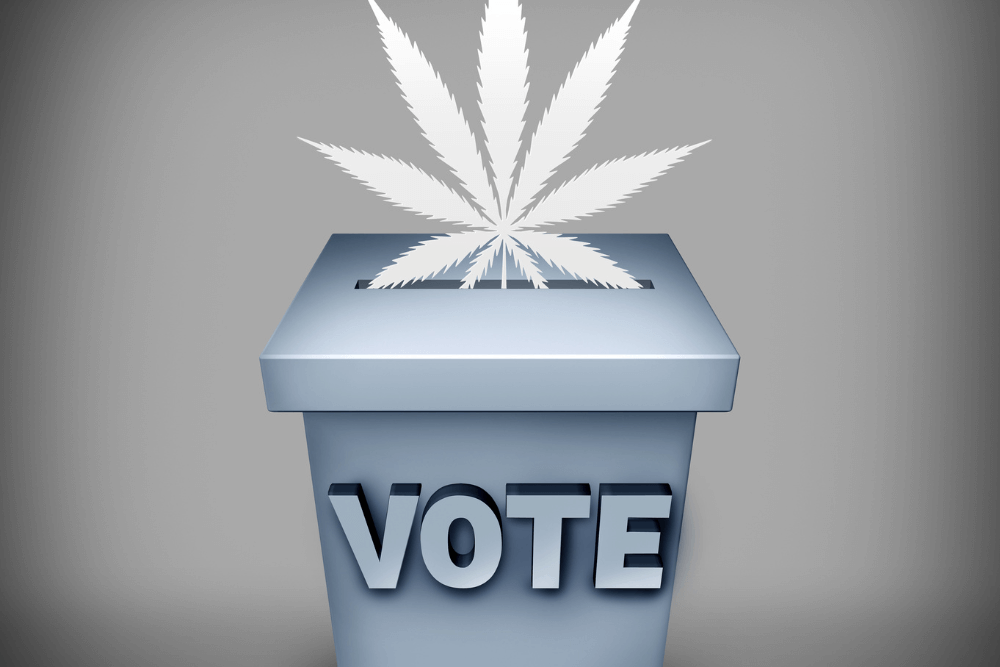
CBD Oracle’s combined analysis of 70 polls shows a decade of increasing support for legal cannabis, with 62% of Americans supporting legalization in 2024.
How many Americans support legalizing cannabis? You might think this is easy to answer: you find the most recent poll and look up the number. The problem is that each individual poll is only a snapshot, based on a randomly-selected group of respondents and influenced by all manner of random factors. It’s like rolling a loaded die: yes, the number with the weight behind it is more likely to turn up, but you can still get an unexpected result on any given roll.
The way you tell a die is loaded is by rolling multiple times and looking at the statistics. Likewise, if you want to see what people really think, you need to look at multiple polls and combine the results statistically.
CBD Oracle has done exactly this with a decade’s worth of poll data on marijuana legalization, and the results show that while the majority of Americans still support legal weed, the number peaked in 2022 and still hasn’t recovered.
Combining Poll Data: CBD Oracle’s Monte Carlo Analysis
CBD Oracle first collected every poll taken from 2015 through to July 2024 that asked a nationally-representative sample of American adults whether they support legalizing cannabis.
As well as national polls, CBD Oracle also looked for polls from Florida and South Dakota, where upcoming ballot initiatives will give voters the option of legalizing cannabis in-state. This resulted in 70 polls for the analysis in total.
The polls were combined using Monte Carlo simulations, which is a common approach to combining political polls. This basically uses the mean and margin of error from each poll to generate multiple simulated “results,” which represent the distribution of results you’d expect if you repeated each poll multiple times. These results were then pooled together, in six-month blocks, to find an overall average for the half-year which accounts for both between-poll and within-poll variability.
You can read more about the methodology in CBD Oracle’s PDF summary of the results.
The Results: 62% Support Legalizing Cannabis in 2024
The decade of national data analyzed by CBD Oracle shows a clear increase in support for cannabis legalization.
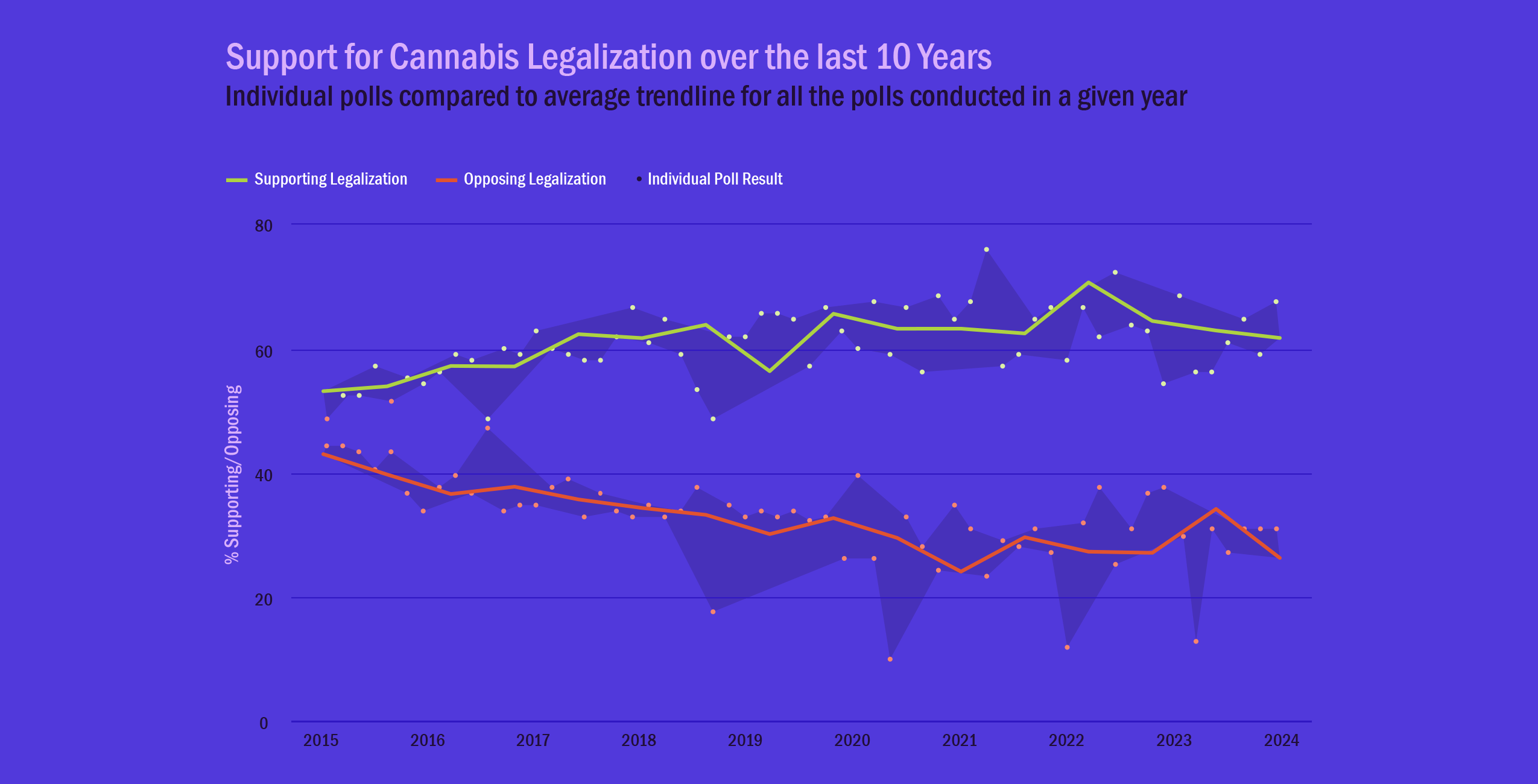
In 2015, 53% of US adults support legalization, but this quickly increased, breaking past three-fifths support in the second half of 2017 (62% support) and reaching a peak of 71% support in the first half of 2022. While support declined slightly after this high-point, it still stood at 62% in the first half of 2024.
Firstly, this is a robust demonstration of something we’ve known for some time: the majority of Americans support legalizing cannabis. However, it also suggests that there may be a decline in support in the past couple of years, with early 2022 showing substantially higher support than 2023 or 2024. This was likely influenced by an SICPA/Harris Poll which found support at 78%, and clearly shows the danger in cherry-picking favorable results when looking for the answer to questions like this.
In the overall context of the results, the apparent decline in recent years doesn’t look so concerning. Prior to this, support was at 63%, and it had declined by to this point again by 2023, but the overall trend over the decade is of increasing support. In addition, the number opposed to legalization remains very low even in 2024, with only 26% against the idea, leaving 12% undecided.
Democrats, Independents and Younger Adults Are More Likely to Support Legal Weed
CBD Oracle also looked at how the results varied based on demographic and other subgroups. While most of these analyses showed no difference, two are worth mentioning.
Perhaps expectedly, political affiliation was a big factor in support for legal cannabis. Based on polls conducted in 2024, 71% of democrats favor legalization, compared to 64% of independents and 48% of republicans. Although republicans are predictably the least supportive, it’s notable that the split is close to 50-50, and it’s possible there will be majority support among republicans in the next few years.
The other major difference was with age. Two-thirds (66%) of adults aged under 45 supported legalization, compared to 60% support among those aged over 45. Here, it’s important to note that both groups supported legalization overall.
Will Florida and South Dakota’s Upcoming Ballot Initiatives Pass?
While there are also relevant ballot initiatives in Nebraska and North Dakota, the two states with upcoming votes and enough polls to analyze were Florida and South Dakota.
For Florida, polls conducted in 2023 showed around 66% of voters in favor of legalization, but the overall result for 2024 declined to 57%. This is concerning for advocates in the state, since the initiative needs 60% support to pass, but there is good news hiding in the details. The two polls conducted in June 2024 found 66 and 64% support, and with a few months of campaigning left, it’s likely that the initiative will pass and Florida will legalize weed.
For South Dakota, the news is less positive. Two polls from 2023 analyzed via Monte Carlo showed 47% support, and the only poll conducted in 2024 put support at just 41.6%. Unfortunately, unless there is a drastic change in the coming months, South Dakotans will have to wait longer to get legal cannabis.
Conclusion: Support for Legal Cannabis Remains High, Despite Recent Declines
CBD Oracle’s analysis shows that support for legal cannabis remains high among Americans, and casts doubt on the relevance of recent declines in support. With a consistent trend towards increasing support and opposition to marijuana legalization remaining low, the data shows that the new “norm” is over three-fifths of Americans supporting legal weed. Individual polls may buck this trend, combining the polling helps you see the overall picture without being misled by individual results.
The tide has already turned; support for legal cannabis is here to stay.
You can access the full report here (PDF).
Member Blog: Understanding Michigan’s Booming Pre-Roll Market and Cannabis Testing Requirements
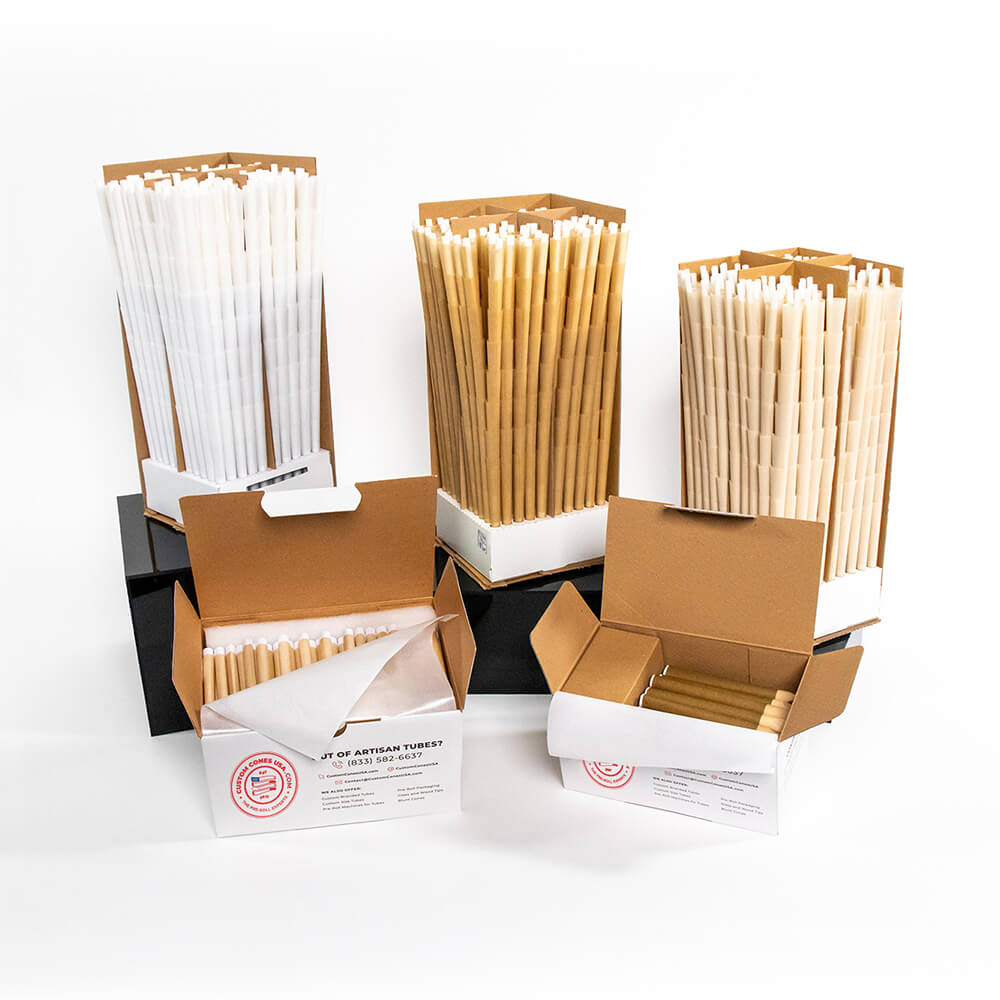
There is no hotter pre roll market in the country than Michigan.
With an average unit price of $6.16 – one of the lowest in the country, according to cannabis analytics firm Headset – retailers have sold more than 56.7 million units for a total of more than $349.8 million through the first seven months of 2024. That puts the state of Michigan in the top spot for pre-roll units sold and second place – to much larger California – in pre-roll revenue.
And sales are actually accelerating, with Michigan posting record high pre-roll sales numbers of nearly $54.9 million in July 2024.
But if you want to compete in the Great Lakes State’s exciting and expanding marketplace, you are going to need to make sure you understand and follow Michigan’s cannabis testing program.
In Michigan, state law requires all “raw plant material” be tested for the following:
- Moisture content and water activity;
- Residual pesticides and chemicals;
These tests are primarily implemented to safeguard consumers from hidden risks in cannabis products.
“Laboratory testing minimizes the risk of exposure to pesticides, microbes, heavy metals, molds, and residual solvents by providing consumers with information about the products they are purchasing and helps to prevent consumption by sensitive populations,” reads the “Sampling and Testing Technical Guidance for Marijuana Products” document created by the state’s Cannabis Regulatory Agency.
For example, moisture content and water activity measurements are indicators of potential mold growth. When water activity exceeds 0.70 Aw, it creates an environment conducive to mold development, which can be detrimental if ingested. This is why Michigan, like many other states, has set a maximum water activity limit of 0.65 Aw for flower and pre-rolls.
Heavy Metals Testing in Michigan
Heavy metals are absorbed through a plant’s roots and can damage all of the body’s vital systems, including the respiratory system, the central nervous system and the reproductive system, even in small doses. That’s why Michigan, like all states, requires products to pass strict heavy metals testing.
But where most states limit testing to the “Big Four” heavy metals of mercury, cadmium, lead and arsenic, Michigan goes a step farther, joining a handful of states that require testing for chromium and even adding nickel to the list as well.
Microbials and Mycotoxins
Though certainly dangerous, heavy metals are less of a threat to human health than microbials and mycotoxins.
Michigan requires testing for standard microbials like yeast, mold, E. coli and salmonella, as well as Aspergillus flavus, fumigatus, niger and terreus.
As for mycotoxins, toxic compounds produced by molds, such as Aspergillus, can suppress the immune system and cause liver damage, so testing for them is certainly a health and safety issue. Michigan law requires testing for Aflatoxin B1, Aflatoxin B2, Aflatoxin G1, Aflatoxin G2 and Ochratoxin A, requiring all to be less than 20 parts per billion to receive a passing grade.
Pesticides and residual chemicals
Michigan allows the use of some pesticides and other chemicals on cannabis, but only those appearing on the Michigan Marijuana Pesticide List, which was updated in early 2024. Pesticides on that list have been reviewed for use by the Michigan Department of Agriculture and Rural Development (MDARD) and may be used in accordance with the label instructions.
For testing purposes, state law requires labs check cannabis for 58 different residual chemicals, each with their own action limits.
Keeping your pre-rolls in compliance
Michigan regulations require tests be conducted in the product’s “final form,” though that applies to the flower itself, according to an email from the Cannabis Regulatory Agency.
“If the pre-rolls were tested as flower, that would be considered final form testing unless something was added to materially change the product,” they wrote.
But with so much time and effort spent ensuring your cannabis stays in compliance with state regulations, why would you want to pack it into pre-rolled cones that haven’t also been tested?
To ensure your cannabis stays clean, only use pre rolled cones that that have also been tested for microbials, pesticides and heavy metals. Medical patients in particular need to be careful to ensure that the paper in their pre-rolls isn’tgoing to make them sick, whether they buy them at a dispensary or pack pre-rolls at home.
In fact, a study from California’s SC labs found that 11% of rolling papers they tested would fail that state’s testing regiment, which doesn’t even include Chromium, and that 90% of rolling papers contained heavy metals with more than 8% containing them at a rate above the allowable limits.
In fact, this year, a team of researchers from Michigan this year tested 53 commercially available pre rolled cones and rolling papers and found varying levels of heavy metals throughout the samples, many of which would have caused failures if included in testing.
“Even if testing is not required, any one issue can harm your brand,” says Custom Cones USA Compliance Manager André Bayard. “It’s important to make sure you work with a company that is as focused on keeping your products in compliance as you are.”
Bayard always recommends confirming your pre-roll supplier has COAs available to prove their products are clean and will pass tests, or will send you samples for you to test before committing to a full order.
“Make sure your supplier is focused on those requirements and is trying to set the industry standard with their products,” Bayard says.
Join Us for More Exclusive Insights on the Michigan Marketplace
Striving to stay informed about Michigan’s dynamic cannabis industry? Mark your calendars for our upcoming Michigan Stakeholder Summit being held in Detroit, MI on Thursday, September 12th.
At the Michigan Stakeholder Summit 2024 you’ll be able to dive deep into the latest trends, regulations, and opportunities shaping Michigan’s cannabis landscape, including hearing directly from Brian Hanna, Executive Director of Michigan’s Cannabis Regulatory Agency. All industry professionals are invited; NCIA members attend free. Register here to secure your spot.
Member Blog: The Importance of Job Descriptions in the Cannabis Industry
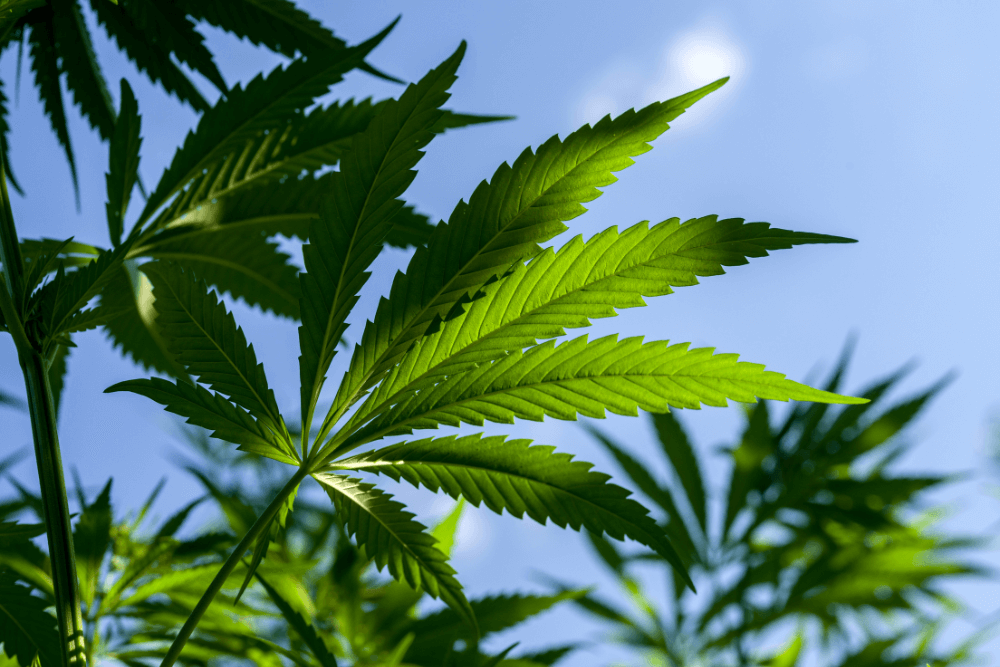
As the cannabis industry continues to grow, businesses face unique challenges, particularly in Human Resources. One critical, yet often overlooked aspect, is the creation and maintenance of clear, effective job descriptions. At Deliberate HR, we understand the well-crafted job descriptions are more than just a formality- they are essential tools for success in the cannabis sector.
Why are job descriptions so important?
-
Defining Roles and Responsibilities
Job descriptions provide clarity by defining the specific roles and responsibilities of each position. In an industry as dynamic as cannabis, where job roles can vary widely- from cultivation to sales to compliance- clear definitions help employees understand their duties and how they contribute to the organization’s goals.
-
Attracting the Right Talent
In a competitive job market, a well-written job description can be the difference between attracting top talent and struggling to fill positions. A precise and appealing job description helps potential candidates understand the role and align their skills with the company’s needs, making the recruiting process more efficient and effective.
-
Ensuring Compliance and Legal Protection
Given the complex regulatory environment in the cannabis industry, job descriptions play a crucial role in compliance. They ensure that roles are aligned with the industry regulations, including safety standards and legal requirements. Additionally, job descriptions can serve as legal documentation, protecting the company in cases of disputes related to employee duties or performance.
-
Enhancing Employee Engagement and Retention
When employees understand their role and how it fits into the larger company mission, they are more likely to feel engaged and motivated. Job descriptions that clearly outline growth opportunities within the company can also boot retention, as employees see a clear path for advancement.
-
Supporting Organizational Structure and Growth
As cannabis businesses expand, job descriptions help maintain an organized structure. They ensure that each role is defined and aligned with the company’s strategic objectives, facilitating smoother scaling and growth. This is especially important in a fast-evolving industry where companies need to adapt quickly.
At Deliberate HR, we recommend that cannabis businesses approach job descriptions with intention and precision. Here are a few tips:
- Be specific and clearly define the duties, responsibilities, and expectations for each role.
- Specify the qualifications needed, including industry-specific knowledge, licenses, or certifications.
- Address any legal or regulatory responsibilities associated with the role.
- Regularly review and update job descriptions to reflect changes in the role or industry.
Job descriptions are more than just a hiring tool- they are a strategic asset that can drive success in the cannabis industry. By clearly defining roles, ensuring compliance, and aligning employee expectations with company goals, well-crafted job descriptions are a cornerstone of effective HR Management.
Member Blog: Cannabis Risk in Distribution – Navigating the Road of Theft, Auto, and More

Welcome back to the unfolding chapters of our Cannabis Risk Management series. In our preceding blogs, we intricately explored the risks woven into cultivation and the dynamic challenges faced by the retail sector. Now, our compass directs us towards the distribution sector, where the landscape extends far beyond the boundaries of a single location.
The Mobile Risks of Cannabis Distribution
At the beating heart of the cannabis industry, distribution orchestrates the seamless movement of products from cultivators to consumers. However, this fluidity introduces unique risks, with theft and auto incidents assuming prominence in the dynamic narrative.
-
Theft in Motion: A Growing Threat on the Move
Unlike the static nature of cultivation and retail spaces, the distribution sector is marked by constant motion. The mobility of distribution vehicles renders them susceptible to theft, both in transit and during stops. The repercussions extend beyond the immediate loss of inventory, amplifying the financial impact. Navigating this evolving threat demands heightened vigilance and strategic risk mitigation.
-
Auto Incidents: The Road Ahead is Paved with Risks
Transporting cannabis products along the highways introduces inherent risks of auto incidents. From road accidents causing damage to products and vehicles to potential liabilities, the road ahead is fraught with financial pitfalls. To safeguard the integrity of the distribution network, a comprehensive insurance policy specifically tailored to cover auto incidents becomes indispensable.
Mitigating Risks in Cannabis Distribution
-
Strategic Route Planning: Mapping the Path to Security
In the dynamic landscape of distribution, strategic route planning emerges as a linchpin in theft prevention. Evading high-crime areas, implementing secure parking protocols, and leveraging technology for real-time tracking are suggested ways to build a robust risk mitigation strategy. By fortifying the journey from cultivator to consumer, strategic route planning becomes a proactive defense against evolving threats.
-
Property in Transit Coverage: Protecting Cargo on the Move
A vital aspect of safeguarding cannabis inventory is ensuring robust property in transit coverage. This specific coverage protects the cannabis products while they are on the road, addressing potential losses due to theft, accidents, or other transit-related incidents. Implementing this coverage can significantly reduce the fiscal impact of such events.
-
Advanced Fleet Management for Safety: Beyond the Roads
Elevating the safety and security of distribution vehicles involves investing in advanced fleet management systems. Real-time tracking, continuous monitoring of driver behavior, and implementation of preventive maintenance measures collectively reduce the risk of both auto incidents and theft. This holistic approach not only protects the products but also ensures the well-being of the team steering the distribution network.
-
Employee Training for Security: Empowering the Frontline
Empowering the distribution team with comprehensive training in security protocols and emergency response measures is foundational. A well-trained team becomes an invaluable asset, making a significant difference in minimizing the impact of theft or auto incidents on business operations. Their heightened awareness and proactive response contribute to a secure and resilient distribution process.
Tailored Insurance Solutions for Distribution
As in cultivation and retail, standard insurance policies may fall short in addressing the evolving risks faced by cannabis distribution. Collaborating with an insurance advisor specializing in cannabis is not merely advisable; it is imperative. Tailored policies comprehensively covering theft, auto incidents, and other challenges unique to the distribution sector provide a robust safety net for operations.
As we embark on the next leg of our journey into the world of cannabis manufacturing, unraveling diverse risks related to work comp, fire, spoilage, humidity, smoke, and equipment breakdown, join us in this quest for knowledge and empowerment. Our mission is to equip you with unparalleled insights and insurance solutions, fostering sustained success in the ever-evolving landscape of the cannabis industry.
For more information, please reach out to Valerie Taylor, Vice President (National Cannabis Practice Leader), Liberty Company Insurance Brokers.
Committee Blog: The Benefits of Intrusion Systems in Cannabis Retail – Ensuring Security and Compliance

The cannabis industry has seen tremendous growth in recent years, with more and more states legalizing its use for medical or recreational purposes. With this expansion comes a need for comprehensive security solutions to protect businesses from potential threats. While they are just one component in a comprehensive security strategy, intrusion systems play a crucial role in ensuring the safety of employees, customers, products and cash for cannabis retailers.
In this blog post, we’ll dive into the benefits intrusion systems specifically tailored for cannabis industry retailers and consultants – and what a full-service security provider like Vector Security, which offers a dedicated cannabis team of experts – can provide when it comes to protecting your business.
Enhanced Security
One of the primary reasons why intrusion systems are essential in cannabis retail is their ability to enhance overall security. By monitoring and detecting intrusion, these systems prevent unauthorized entry into sensitive areas such as stock rooms, storage areas, cash registers and safes, and computer/networking equipment and devices. This level of control significantly reduces the risk of break-ins, internal and external theft, vandalism and other criminal activities by limiting access to authorized personnel only.
Immediate Alerts
Intrusion systems are equipped with advanced technology that can detect unauthorized entry or tampering with security equipment. Motion detectors, glass-break and door/window sensors trigger visual and audible alarms to ward off intruders, while providing real-time alerts to store owners and other stakeholders as well as alarm monitoring operators. If the emergency is real, authorities are dispatched to the location of the intrusion. This swift response time is crucial in preventing further damage or loss. Professionally monitored intrusion systems ensure your cannabis facility is protected around the clock – during and after business hours, and even on holidays.
Compliance with Regulations
Operating within the cannabis industry means complying with strict regulatory frameworks that can vary from state to state. These regulations often include guidelines related to security and surveillance. Intrusion systems are a vital component in meeting these requirements. By maintaining accurate records of security incidents, cannabis retailers can demonstrate their commitment to compliance during audits. Here is where a seasoned security provider, like Vector Security, can advise and design a system that complies with regulatory requirements.
Protection of High-Value Products
Cannabis products have significant value, making them attractive targets for criminals. Whether it’s the actual flower, edibles or concentrates, protecting these assets is crucial for a successful business. Intrusion systems help safeguard inventory, reducing the risk of internal and external theft and ensuring product availability for legitimate customers.
Cash Management
Cash remains a primary form of payment in many cannabis dispensaries. This makes retailers vulnerable to theft and robberies. In areas where cash is kept, intrusion systems can provide an added layer of security by securing cash registers, safes and other cash-handling areas.
Panic Alarms
In addition to detecting unauthorized entries, modern intrusion systems often include panic alarms. These alarms allow employees to quickly signal for help in emergency situations. Whether it’s a medical issue, a threat from a customer or any other crisis, panic alarms provide immediate assistance. Install panic buttons around the store and in areas with cash so employees can safely and discreetly summon authorities in the event of an emergency, like during a burglary or hold-up robbery.
Scalability
As the cannabis retail industry continues to expand, scalability becomes crucial. An initial investment in a comprehensive and flexible security solution ensures that the system can grow along with your business. Whether opening additional stores or cultivation facilities, retailers should be able to seamlessly integrate new locations into their existing security infrastructure. Make sure your security provider can adapt your security solution to respond to your business’s changing needs, including responding to new threats or opportunities.
Conclusion
Intrusion systems are not only about preventing break-ins, they are also essential tools for maintaining compliance, protecting valuable assets, and ensuring the safety of employees and customers. By investing in robust security solutions, cannabis retailers can focus on their core business knowing that their facilities are well-protected.
Remember that while effective at providing a layer of protection, intrusion systems are just one component of a comprehensive security plan for cannabis businesses. It’s beneficial to work with a full-service security provider that can design a complete plan that integrates and streamlines all parts of your security, such as video surveillance, access control, fire and environmental monitoring, panic alarms and more. Working with a full-service vendor that has expertise in the cannabis industry ensures you’ll receive the range of products and services you need, with tailored solutions that meet the unique demands of your cannabis business.
Member Blog: How Barcoding Can Improve Your Cannabis Sample Management

Cannabis testing is fundamental to ensuring the quality and safety of products in this rapidly growing industry. Within your lab environment, you face many challenges, from varying testing requirements across states to equipping your lab with the right analytical instruments and qualified professionals. Another critical aspect of cannabis testing is preparing individual samples and ensuring accurate data, which can be daunting.
When it comes to chromatography, a significant amount of time is often spent on the preparation of samples. Within the final stages of your preparation, the manual process of printing and hand-applying labels or hand writing with a sharpie can be time-consuming, potentially slowing down laboratory workflows. The time spent on printing, peeling, and precisely applying labels manually is time that could be redirected towards more important tasks. Additionally, hand-labeling your samples increases the risk of errors, such as lost samples and data mix-ups, which can compromise the accuracy and reliability of your results.
There is a solution that not only reduces errors and saves time but also enhances data integrity—barcoding your samples can greatly improve operations within your cannabis testing lab.
The Power of Barcoded Vials
The first step toward enhancing sample identification begins with adding a unique identifier to each vial. By implementing a barcode as the unique identifier, laboratories can confidently trace the entire lifecycle of a sample, from its creation to analysis and storage. This digital fingerprint facilitates seamless tracking within a laboratory, standardizes data exchange, and promotes collaboration across systems and institutions. 
Here’s how barcoded vials can transform your lab:
- Improve Your Audit Trail: Implementing barcoded vials enables effortless tracking and precise documentation of each experiment step. This enhancement not only improves compliance with Good Laboratory Practice (GLP) regulations but also enhances data quality and integrity.
- Streamlined Sequence Table Management: Reduce the risk of misloading samples in the autosampler rack and sequence table. By simply scanning the barcode and placing your samples in the tray, you can significantly decrease the potential for errors.
- Enhance Efficiency: Manual labeling is time-consuming and error prone. Barcoded vials streamline your workflow, allowing for faster processing times and reducing the risk of human error.
How to Integrate Barcoded Labware to Your Workflow
Integrating barcoded chromatography vials into your lab workflow or automated prep systems is seamless. Simply add a USB scanner to your equipment, and experience a continuous workflow from sample preparation to data management: 
- Identify Samples in LIMS: Easily integrate barcoded data into your Laboratory Information Management System (LIMS) for streamlined data management.
- Scan into Sequence Table: Use the USB scanner to scan vials into the sequence table, enhancing traceability and organization.
- Load into Autosampler Rack: Place your pre-barcoded chromatography vials into the autosampler rack without the hassle of manual labeling.
- Sample Prep with Confidence: Run your experiments with confidence, knowing that your samples are correctly located and identified.
Challenges of Manual Labeling
Adding a barcoded label to your chromatography vial ensures a reliable and traceable identifier. However, achieving the optimal positioning of labels on your vials take a high level of precision. In a field where accuracy is vital, the meticulous task of aligning labels becomes critical. The label must not only be placed in the correct position, but also without any wrinkles. This is especially crucial for instruments equipped with built-in scanners designed to read barcodes. A misaligned or wrinkled label can obstruct the scanner’s ability to accurately capture the barcode data, introducing the potential for errors in sample identification.
Another challenge of manual labeling is preventing barcode duplicates, especially when multiple individuals in labs are involved in the printing process. Coordinating and managing sequences manually can lead to errors, potentially causing duplicate barcodes. This scenario not only compromises data integrity but also limits the smooth functioning of laboratory operations.
Outsourcing Label Application 
To address these challenges and increase efficiency in your testing environments, labs should consider outsourcing their label application, such as Labware Prep™ Services by Computype. This alternative solution allows laboratories to remove the printing and application of labels inhouse. By outsourcing this tedious process, you eliminate the prep work needed before testing and analysis, streamlining laboratory workflows and mitigating the risks of mislabeled or lost samples. With this service, you can experience significant time, budget, staffing, and inventory savings.
Computype’s Labware Prep™ Services go beyond adding barcodes to your labware. Your labware arrives ready for immediate use, procured, custom-marked, prepared and packages to your specification. Your specific needs, combined with our barcode sequence management service, global account management, and strict quality standards ensure that you’ll be spending more time on scientific activities, and less time worrying about labware and labeling. Here’s how we can help:
- Labeling, Marking, and Sequence Management: Receive your labware pre-labeled to your specifications, including custom numbering and sequencing. Select from a variety of marking technologies designed to survive chemical and temperature exposure.
- Labware Procurement: Save time and money by outsourcing the procurement of consumable labware. We source containers according to your desired specifications and budget, ensuring you receive high-quality labware without the hassle.
- Tare Weighing: Free yourself to focus on the science while we handle the weighing. Each piece of labware is weighed to a tenth of a milligram, with an output file provided for easy reference.
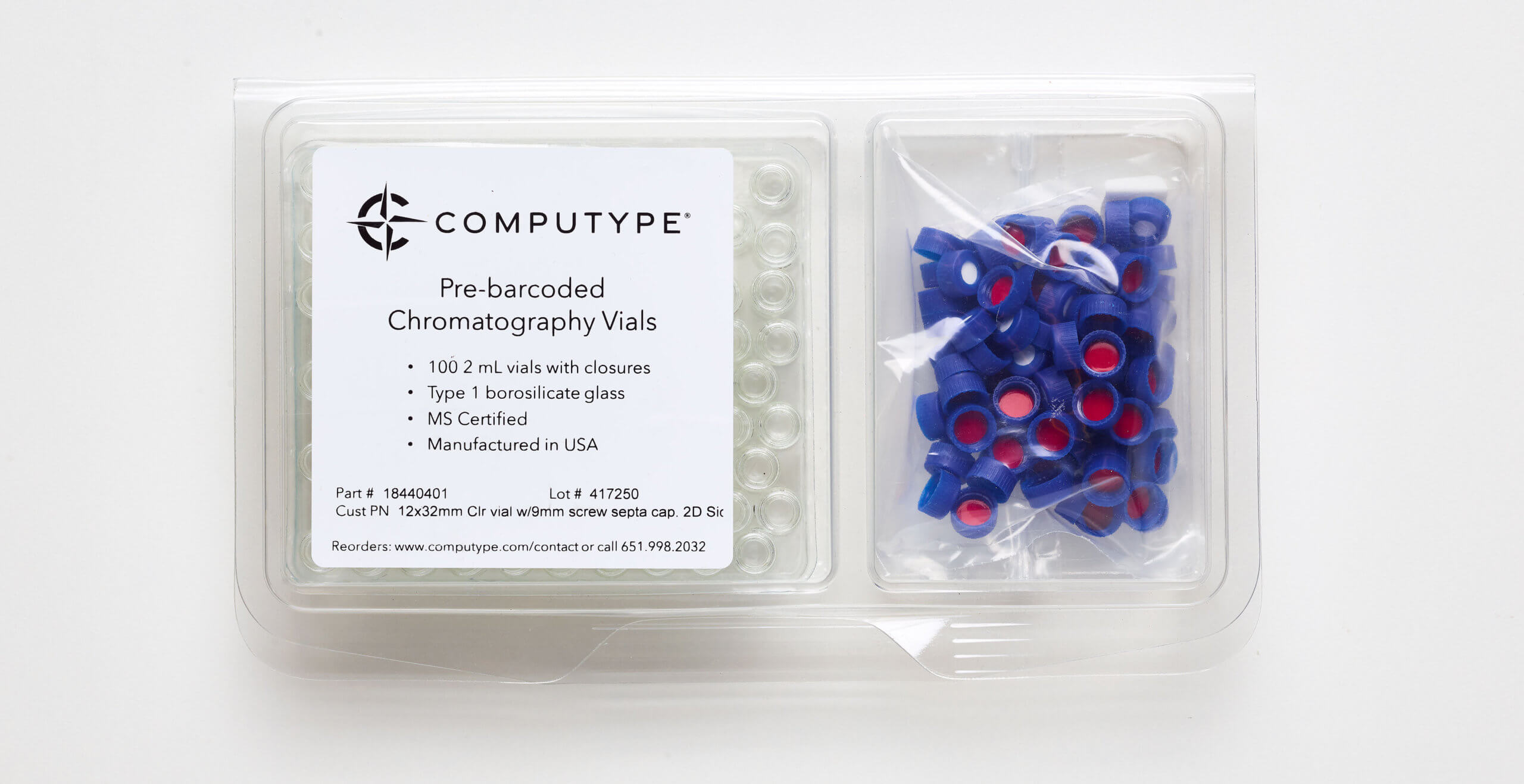
This service is a transformative solution for chromatography testing, offering a strategic advantage by combining efficiency, precision, and compatibility with automation. Laboratories leveraging these services experience not only enhanced operational efficiency but also the assurance of accurate and reliable results in their chromatography testing.
Transform Your Research Environment
As the cannabis testing industry continues to grow and evolve, accurate sample management has never been more vital. By partnering with Computype, you can eliminate the inefficiencies of hand labeling and ensure your lab operates at peak productivity. Our Labware Prep™ Services provide the ultimate solution for enhancing your lab’s efficiency, accuracy, and compliance.
Eliminate the hassle of individually labeling each vial and let Computype transform your laboratory with the power of barcoding. Our experts are ready to assist you in streamlining your workflows and ensuring the highest standards of sample management. Contact Computype today to learn more about how our Labware Prep™ Services can benefit your lab.
Member Post: The Bank Black Program

By Cimone Casson, Cannas Capital Holdings
Social equity programs are designed to address historical and systemic inequalities but often face various specific and unique challenges that can impede their effectiveness. Despite many attempts across the country, social equity programs have yet to make the impact needed to change the trajectory of equity and equality in the commercial cannabis industry. To tackle social equity’s biggest hurdles, we have to understand two things: there is profit in diversity, and investing in minority companies is a long-term play. Although access to capital is one of the biggest obstacles that social equity awardees face, they are much bigger and divergent. Let’s discuss some of the reasons that social equity programs have not moved the needle or made an impact on emerging and sustainable minority ownership in cannabis.
Of course, the elephant in the room is access to capital issues. This is a major problem. Many social equity programs are underfunded, which limits their ability to provide the necessary resources and support to the target populations. More states have adopted state-funded cannabis grants and limited lending programs, but this structure lacks the investment resources to credit sustainable businesses. Grants and small-scale forgivable loans under $200,000 are a great steppingstone but these businesses need to establish consistent fundable business credit profiles. More banks and financial institutions have entered the cannabis space (under U.S. Department of Treasury guidelines established in 2014 and Federal Reserve Bank guidance established in 2015) and are considering lending opportunities but they need creditworthy businesses to give them more of an incentive to offer loans. Additionally, once the banking regulatory climate changes, which it will, commercial cannabis companies must be ready to take advantage of capital opportunities.
Next, many programs are designed with short-term goals in mind and may not address the root causes of inequality, which require long-term and sustained efforts. Investing in minority businesses is a long-term play. We expect minority businesses to be an overnight success, despite deeming them economically, socially, or geographically disadvantaged or to have somehow magically overcome racial and gender-based structural barriers to business entry, scaling, and sustainability that still exist. These expectations are unrealistic, the success of this industry is in inclusion. Achieving this will take the adoption of joint venture programs, supplier diversity initiatives, public and private partnerships, and strategic business planning, that have worked in other industries. We must accept the reality of social economics, in which every culture has a relationship with money. Persistent economic disparities undermine the efforts of social equity programs, as economic inequality often intersects with other forms of social inequality. Understanding the habits, views, and relationships with funds for these disadvantaged communities’ groups can aid in establishing stronger pathways to leveling the playing field and developing general wealth.
If we truly wish to overcome the many roadblocks failed social equity programs face, we have to reexamine creditworthiness. Current underwriting metrics create additional hurdles for minority businesses. Many Community Deposit Financial Institutions, banks, and lenders will have to think about credit differently and set up various avenues and pools of capital to assist diverse businesses. I suggest adopting a socio-economic underwriting system such as Cannas Capital Holdings’s Bank Black Program. Our mission is to bridge the wealth gap via four pillars Social Equity, Social Economics, Social Entrepreneurship, and Social Enterprise. We have designed an AI operating system that will perform underwriting solutions developed with unique metric criteria that consider the disadvantages and advantages of offering provisions for diverse business owners to develop social enterprises in our communities. In addition to many traditional underwriting requirements such as Management Team, Payment History, and Collateral Support, we also employ Community & Demographic Analysis, Social Capital Assessment, Institutional Support, Risk Mitigation Strategies, Long-Term Sustainability, Regulatory Compliance, and Continuous Monitoring as underwriting standards.
Improving the effectiveness of social equity programs often requires addressing these challenges through better funding, streamlined processes, robust data collection, community engagement, and a commitment to long-term, systemic change.
Member Blog: The Science of Smokeability

While there’s a lot more science involved in the cannabis industry today than back when folks were growing in closets or on hidden hillsides, none of that science has focused on the end user.
We know how to increase yield and cannabinoid production, for example, but there hasn’t been any real research done on how cultivation techniques or delivery methods affect the smokeability of the product from the consumer standpoint.
Until now, that is.
The cannabis industry is entering a new era of scientific rigor and consumer-focused research with the launch of a groundbreaking study called The Science of Smokeability (SOS). This multi-year research project, spearheaded by Custom Cones USA and the DaySavers brand in partnership with the Cannabis Research Coalition and The Network of Applied Pharmacognosy (NAP), aims to revolutionize our understanding of cannabis cultivation, processing and consumption.
Unlike previous research that primarily focused on things like cannabinoid percentages, the SOS study seeks to establish clear links between cultivation and manufacturing practices and the end-user experience. By doing so, it has the potential to transform product quality, consistency and safety across the industry.
A Comprehensive Approach
One of the most innovative aspects of the SOS study is its comprehensive approach. It combines controlled laboratory experiments with consumer research, creating a holistic view of the smoking experience. This methodology allows researchers to analyze various factors that influence cannabis quality, including mineral content, nutritional content (flushing), nitrosamines (potential carcinogens), moisture content, and their effects on ash color, smoke composition, and overall smoke quality.
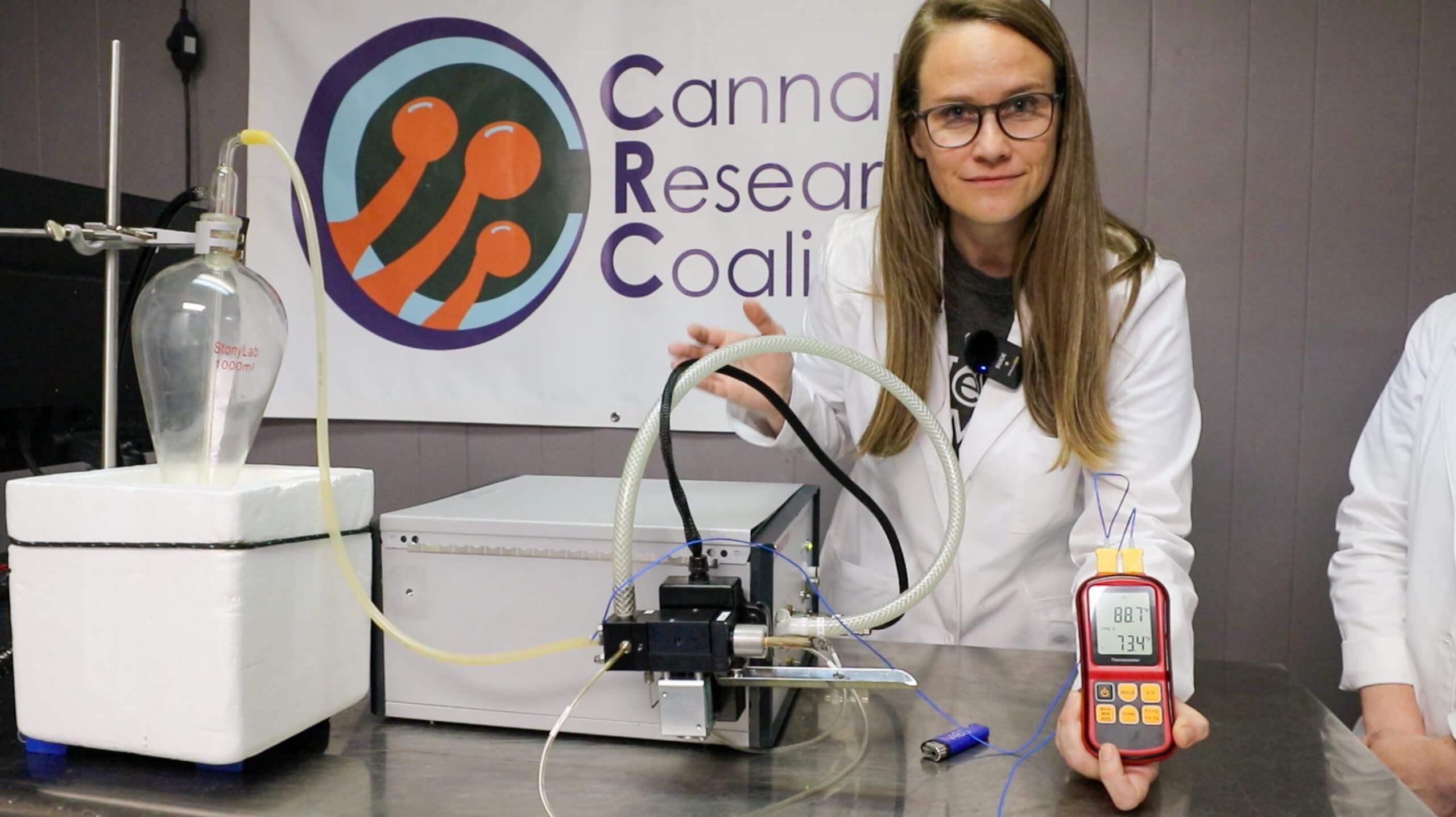
On the lab side, the SOS will be led by conducted by qualified researchers from various organizations including The Cannabis Research Coalition (CRC), an academic cultivation research group that is developing advanced cultivation techniques aimed at optimizing yield and quality of medicinal cannabis, and The Network of Applied Pharmacognosy (NAP), a nonprofit organization focusing on providing quality cannabis materials and tracking the experience of users.
Dr. Allison Justice and Dr. Markus Roggen, two of the top researchers on the study are previously known for their groundbreaking work in exploring the color change of ash in cannabis smoking. The SOS study has also partnered with Controlled Chemistry, experts in cannabis smoke and inhalation studies for cannabis, leveraging cutting-edge technologies and methodologies.
“This cross-departmental research collaboration extends beyond mere acquisition of sustainable and profitable cultivation and post-harvest metrics; we are actively establishing the benchmarks for ensuring the highest standards in producing flower intended for combustion” said Justice, founder of the Cannabis Research Coalition.
To gain consumer insight, DaySavers will be paying 200 lucky people, drawn at random, to receive and smoke two pre-rolls and then provide feedback on the experience. That data will be combined with the lab work to create the final reports.

This unique and consumer-centric approach and focus on “smokeability” aligns with the industry’s growing focus on end-user satisfaction and, we hope, could lead to products that better meet consumer preferences.
Developing Standards
The first phase of findings is expected to be published in the coming months and will demonstrate how to optimize cultivation metrics to save time, money and resources while enhancing product quality.
The study will also include experiments on infused pre-rolls, testing different infusion processes and their effects on temperature and cannabinoid/terpene delivery.
We think the implications of this research for the cannabis industry will be far-reaching. By understanding how different cultivation and processing variables affect the final product, growers and manufacturers can fine-tune their practices to create superior cannabis products. This could lead to more consistent, higher-quality pre-rolls and other cannabis products in the market.
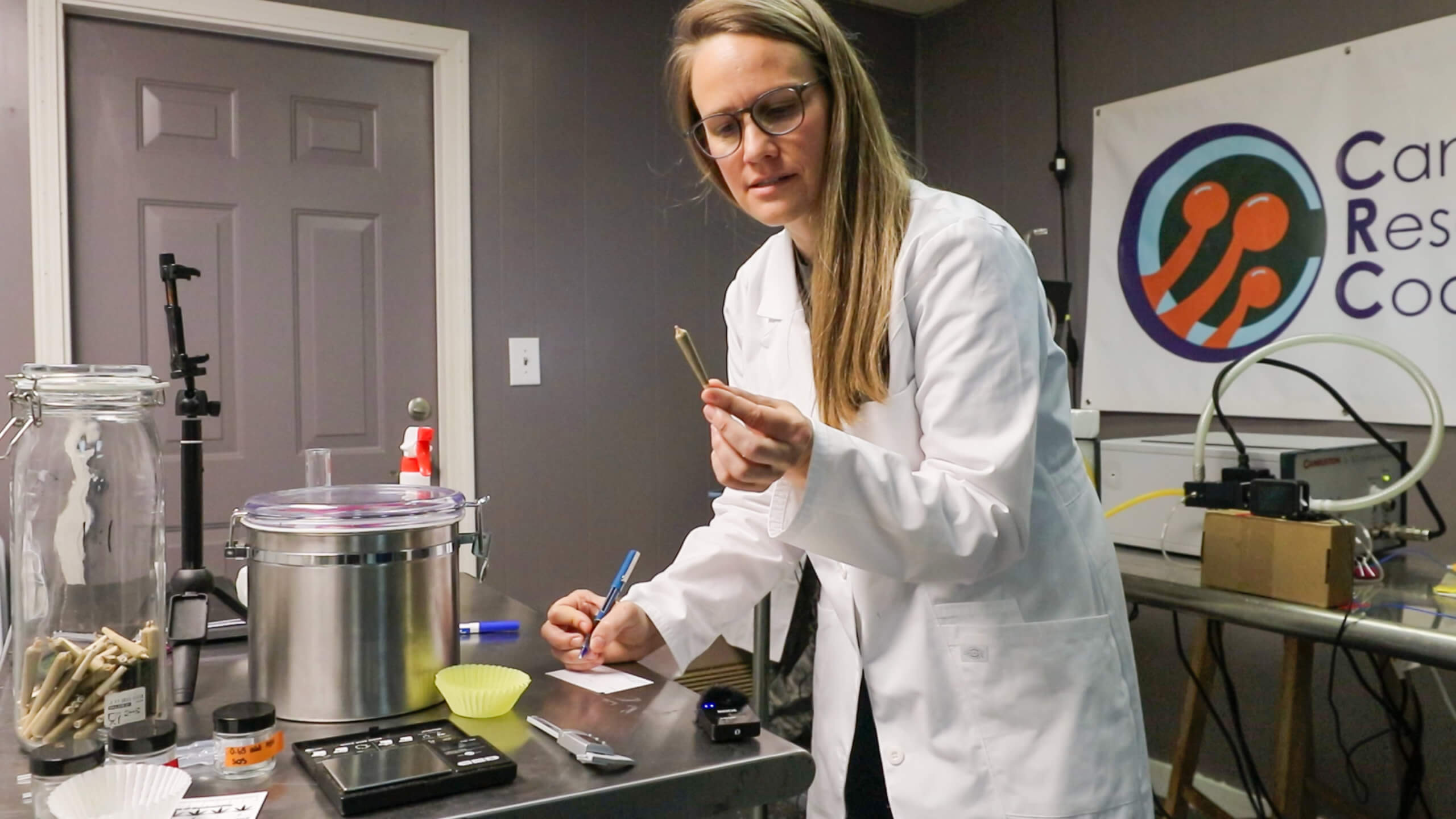
The findings from the SOS study will also be shared with ASTM International, an organization that establishes industry standards. The hope is that it leads to the development of new benchmarks for quality and safety in cannabis cultivation and product manufacturing. Moreover, by providing solid scientific data on cannabis smoke composition and quality, the study could influence cannabis policy decisions. This is particularly significant for states that are hesitant to permit smokable flower due to uncertainties about the substances produced in cannabis smoke.
For cultivators, the study could provide valuable insights into optimizing their growing techniques for better quality. Manufacturers could use the findings to improve their processing methods and create more appealing products. Retailers and budtenders could leverage the research to provide more informed recommendations to consumers.
Plus, the study’s focus on safety and quality could help address concerns about the health impacts of cannabis smoking. By identifying factors that contribute to a “safer” smoking experience, the industry could potentially mitigate some of the health risks associated with cannabis use.
At Custom Cones USA and DaySavers, we’re known for our commitment to transparency and the rigorous testing of our pre-rolled cones, as well as other products like blunt cones and the Smoke Temple Cross Cone, for pesticides, heavy metals and microbials. We do this, despite it not being required, because we believe it makes a better, safer final product for the end user. Our hope is that by focusing this study on “smokeability,” others in the industry will put the consumer first as well.
A New Kind of Study
The Science of Smokeability study marks a pivotal moment in the evolution of the cannabis industry. As the cannabis market continues to mature and evolve, research like the SOS study will be crucial in establishing cannabis as a legitimate, well-understood, and responsibly produced consumer product.
By bringing together scientific rigor, consumer experience and industry expertise, it has the potential to drive innovation, improve product quality, shape the future of cannabis cultivation and consumption.
The SOS promises to enhance our scientific understanding of cannabis as both a medicinal and recreational product, potentially revolutionizing how we approach cannabis cultivation, processing and consumption in the years to come.
And we’re excited to be a part of it.
Member Blog: Financial Services Survey – Seeking Licensed Cannabis Operators to Participate

As public opinion shifts and state and federal policies on cannabis continue to evolve, more banks and credit unions are venturing into this market. With competition intensifying, financial institutions must offer products and services that meet the changing needs of the industry.
Shield Compliance, a leading compliance platform for cannabis banking, is conducting a survey of licensed cannabis operators regarding their satisfaction with the banking partners, products, and services available to them. The survey allows licensed operators to offer valuable insights and shape financial institutions’ services going forward.
Shield welcomes all licensed cannabis operators to participate. The survey consists of short, multiple-choice questions and should only take about ten minutes to complete. You may answer the survey anonymously, or you may provide your contact information to be entered to win an Amazon gift card worth $200.
To participate in the survey, please click here or copy and paste it into your browser. Additionally, we encourage you to share this survey link with other cannabis operators within your network who may be interested in contributing to this study. The more diverse responses we receive, the more comprehensive our findings will be.
The survey will be available until August 9th.
Thank you for your participation.
Member Blog: CBD When Pregnant

Disclaimer: The content in this blog is for informational or educational purposes only and does not substitute professional medical advice or consultations with healthcare professionals.
If you’re pregnant or trying to conceive, you may have heard of the potential benefits of CBD during pregnancy. Alternatively, you may already take CBD oil regularly and are unsure whether you should continue. Here, the team at Goodray’s explores the latest information around CBD in pregnancy and whether it is a safe supplement during this time.
What is CBD?
Cannabidiol, or CBD, is a natural compound found in the cannabis plant. Unlike tetrahydrocannabinol (THC), CBD does not produce a high or any level of intoxication. CBD has become known for its therapeutic benefits, which include reducing anxiety and improving sleep. With these benefits, it’s clear why you might consider using it during pregnancy. However, it is crucial to understand the research around CBD before making a decision.
Is CBD Safe to Use During Pregnancy?
Currently, there is not enough research on CBD in pregnancy to determine whether it is a safe supplement. While research shows that CBD may have potential benefits for a range of medical conditions, its effects on fetal development and pregnancy are unknown.
Many healthcare professionals advise against using CBD during pregnancy due to this lack of research. If you are considering using CBD for the first time or continuing to use it, you should speak directly with your healthcare team. This allows you to make an informed decision based on your individual circumstances.
Potential Benefits of CBD During Pregnancy
CBD oil has many therapeutic benefits, particularly in stress and anxiety relief. During pregnancy, some mothers-to-be may experience heightened levels of anxiety and stress. CBD oil has the potential to treat anxiety and promote relaxation during this time.
Additionally, sleep issues are common during pregnancy, and CBD oil may help improve sleep quality. Some expectant mothers may find it difficult to get a good night’s sleep due to discomfort or hormonal changes. CBD’s calming properties might offer some relief and better sleep.
Despite these potential benefits, it’s important to remember that the research supporting the use of CBD during pregnancy is not yet available. Therefore, it is crucial to be mindful and consider whether it is the best choice for you.
Potential Risks of CBD During Pregnancy
Much like the benefits, the risks of using CBD during pregnancy are largely unknown. While there is no research to suggest that CBD causes any problems, there is also no research to the contrary. Some health professionals argue that CBD could potentially interact with other medications or supplements required during pregnancy, impacting fetal development.
Moreover, the quality and purity of CBD products can vary significantly. If not sourced from reputable places, CBD products can contain other substances, including THC or other cannabinoids, which you would not want to ingest while pregnant. Ensuring you source pure CBD oil should be a priority if you choose to use it.
Understanding the Research and Expert Opinions
The current body of research on CBD use during pregnancy is limited, and most studies are either in early stages or conducted on animals. This makes it challenging to draw definitive conclusions about the safety and efficacy of CBD for expectant mothers.
Healthcare professionals generally take a cautious approach due to the lack of comprehensive human studies. Organizations such as the American College of Obstetricians and Gynecologists advise against the use of cannabis and its derivatives, including CBD, during pregnancy. This caution is primarily due to the potential unknowns and the precautionary principle of “first, do no harm.”
Consulting with Your Healthcare Provider
Given the uncertainties surrounding CBD use during pregnancy, it’s essential to consult with your healthcare provider. Your doctor can provide personalized advice based on your health history and current condition. They can also help monitor any potential interactions with other medications you may be taking.
If you and your healthcare provider decide that using CBD is appropriate, it’s crucial to source high-quality products from reputable suppliers. Look for products that have been third-party tested for purity and potency. Avoid products with additives, contaminants, or THC.
Alternatives to CBD for Managing Pregnancy Symptoms
If you are looking for natural ways to manage anxiety, stress, or sleep issues during pregnancy, there are several alternatives to consider:
- Exercise: Regular physical activity, such as walking, swimming, or prenatal yoga, can help reduce stress and improve sleep.
- Mindfulness and Meditation: Practices like mindfulness, meditation, and deep breathing exercises can promote relaxation and reduce anxiety.
- Diet and Nutrition: Eating a balanced diet rich in essential nutrients can support overall well-being and help manage stress.
- Herbal Teas: Some herbal teas, such as chamomile, can promote relaxation and improve sleep. However, always consult with your healthcare provider before trying new herbal remedies.
- Support Networks: Building a support network of family, friends, or support groups can provide emotional support and reduce feelings of isolation.
Final Thoughts
CBD oil is a natural product with potential therapeutic benefits, but whether you choose to take it during pregnancy is a personal decision. Given the lack of substantial research, it is essential to weigh the potential benefits against the unknown risks carefully.
Discussing your options with your healthcare team is the best way to make an informed decision that prioritizes your health and your baby’s well-being. Goodrays crafts and sells high-quality CBD oils and products designed to complement your lifestyle, free of any potentially harmful substances. However, it is crucial to ensure any CBD product you consider is sourced from a reputable provider and meets high standards of purity and quality.
In conclusion, while CBD may offer potential benefits, the safety of its use during pregnancy remains uncertain. Always prioritize open communication with your healthcare provider and make choices that align with your health needs and pregnancy journey.
Committee Blog: Understanding the Nutritional Demands of Cannabis
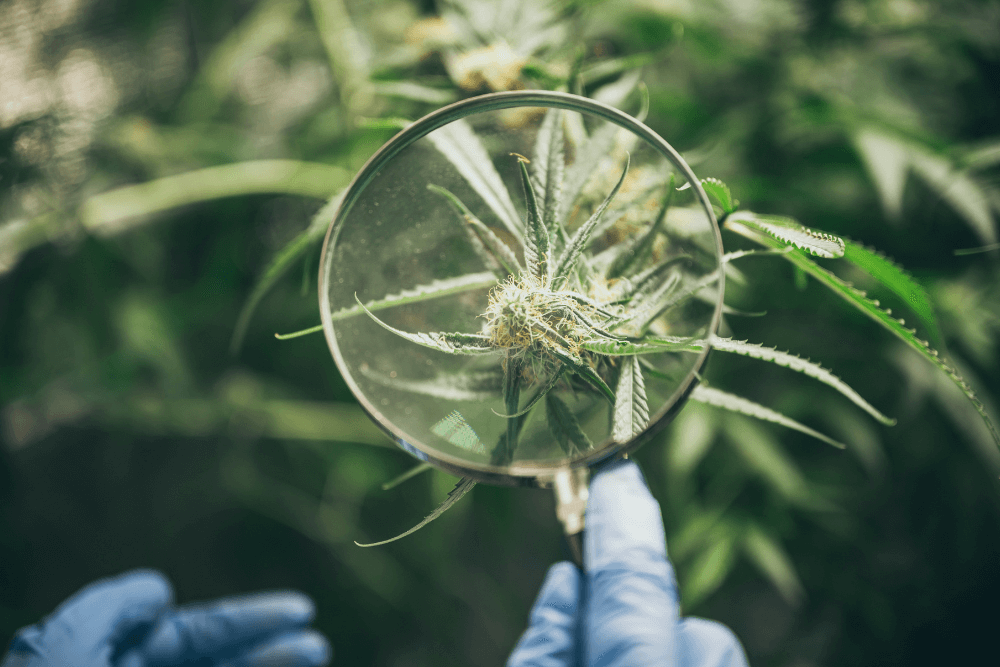
The nutritional demands of cannabis are still not well understood. Due to the legal status of the plant, intense studies on cannabis nutrition have been limited. The subtleties of plant nutrition are not well understood, particularly in cannabis. Nickel was not recognized as a plant essential nutrient until 2004. The presence of a single micronutrient deficiency can decrease the production of fruit and some flowers in excess up 30%.
The Presence of Physical Symptoms
The physical symptoms of plant deficiencies and toxicities typically don’t manifest from anywhere between three and nine weeks. Usually, by the time these physical symptoms appear visually, the damage has already begun to occur. Physical symptoms of plant nutrition vary considerably and there’s substantial overlap between the visual characteristics of symptoms. Nutritional deficiencies can sometimes be caused by the toxicity of another element. For example, an excess of magnesium can inhibit the plants’ ability to uptake calcium.
The Importance of Soil and Growing Media
The soil/growing media used during the cultivation process can impact nutrient absorption in several ways, primarily depending on its physical and chemical characteristics. Cannabis prefers well-draining media with a pH range of 5.8-6.2. The pH of the media itself can enhance or reduce the plants’ ability to absorb certain nutrients. For example, iron becomes decreasingly soluble at higher pH levels. The drainage of the media is highly dependent on the growing style and environment, but generally, a well-draining growing media allows for healthy roots and maximum nutrient absorption. The media acts as a sort of nutrient reservoir for the plant’s roots.
Leaf Tissue Analysis
Leaf tissue analysis has been a long-utilized tool in traditional agriculture. Its presence in cannabis is limited primarily due to the long-standing illegality of the plant. However, there has been major interest recently in using this tool in cannabis cultivation. The basic premise is that fan leaves are removed from the plant, dried to completion, and analyzed at an analytical laboratory for primary, secondary, and micronutrients. One of the main advantages of this is the guesswork is taken out of the identification of the toxicity or deficiency. Visual symptoms of toxicities and deficiencies can have overlapping visual cues. The nutritional issues may be far more complex than an issue with a single element. By having empirical data, it allows the cultivator to compare the analytical results to established target values. From there, the cultivator can adjust the fertilization program to mitigate any potential toxicities or deficiencies. Regular monitoring of nutrient levels allows for proactive adjustments of the fertilization program. This, in turn, can lead to optimization of quality and yield.
Fertilizer
Fertilization is one of the most important aspects of any cultivation. A dialed in nutrient program optimizes the speed of growth, quality of the product, and overall yields. Fertilization can be a complex puzzle and no two cultivators grow in the exact same way. By analyzing the fertilizer, nutrient solution, plant tissue, water, and growing media the cultivator can trace back to the source of any potential issue. A common issue in cannabis cultivation is iron deficiency, this can be caused by an excess of manganese as cannabis will selectively absorb manganese over iron. The iron levels may be completely sufficient in the nutrient solution, but the excess manganese mitigates absorption. A typical response to an iron deficiency would be to add more iron, by using plant tissue and nutrient data, it can be discerned that the solution to the problem is a reduction in manganese and not the addition of more iron.
Water
Water quality is one of the foundations to successful cannabis cultivation. Testing water prior to planting and throughout the growing season can help prevent issues before they occur. If the source water for the nutrient solution originates from a well, it is important to understand the mineral content of the water so that fertilization can be adjusted accordingly. If the water is filtered, it is a useful tool to monitor the life of the filters. As reverse osmosis (the most common type of filtration used in cannabis cultivation) filters age, the boron concentration in the filtered water begins to rise considerably. In addition to this, the presence of excess chlorine or chloramine can create issues with nutrient absorption.
Environmental Conditions
Environmental conditions play a significant role in nutrient absorption and overall plant health. Nutrient levels can be optimized in the fertilizer solution, but environmental effects can prevent optimized nutrient absorption. Humidity, temperature, light, CO2, etc. can all greatly impact the plants’ ability to uptake nutrients. Optimization of these conditions is critical to a successful cultivation.
Conclusion
While the nutritional demands of cannabis are still not fully understood, leaf tissue, water, soil, and fertilizer analysis can assist immensely in the identification and mitigation of nutritional deficiencies and toxicities. These tools allow cultivators to make data driven decisions and prevent issues before they occur. Optimizing nutritional levels in cannabis maximizes the quality and yield of the plants.
Make Your Comment Count! A Guide for Industry Advocates

Understanding the Importance of Effective Public Comments on Cannabis Rescheduling Proposals
The cannabis industry is abuzz with anticipation over the rescheduling proposals. From industry groups to advocacy organizations, companies, and activists, discussions on submitting effective public comments are in full swing. This marks a significant moment as the federal government proposes to reclassify cannabis for the first time, moving it from Schedule I to Schedule III. This move acknowledges cannabis’s medical value, a recognition long sought after. Amidst this pivotal moment, it’s crucial to ensure that your public comments on cannabis rescheduling are not only heard but are also meaningful and impactful.
For a comprehensive toolkit to assist in crafting your public comment, visit NCIA’s resource page here.
Tips for Crafting Effective Public Comments on Cannabis Rescheduling Proposals
1. Be Respectful
While it may seem obvious, maintaining respectful language is crucial. Emotions can run high when discussing cannabis regulation, but name-calling or using foul language can undermine your message. Ensure your comments are taken seriously by maintaining a professional tone.
2. Stay on Topic
Focus your comments narrowly on the specific cannabis rescheduling issue at hand. Whether addressing the DEA or local city council, avoid including unrelated grievances. For example, if discussing zoning laws affecting cannabis businesses, refrain from delving into tax issues or home grow regulations. This clarity strengthens your argument and prevents your message from appearing scattered.
3. Clearly State Your Requests
Ensure your asks are explicit and easy to identify. Begin and conclude your letter with a clear statement like, “I am asking you to…”, followed by the action you want. Decision-makers review numerous letters daily, so clarity on your stance and desired action is essential for your public comment on cannabis rescheduling to be counted.
4. Provide Supporting Data and Stories
Back your arguments with relevant data and compelling anecdotes. This enriches your public comment on cannabis rescheduling and provides context for your requests. Ensure your evidence supports your advocacy effectively.
The Importance of Advocacy in Cannabis Rescheduling
Public support has been instrumental in progressing cannabis rescheduling reform. However, societal attitudes towards cannabis are dynamic, and advocacy efforts are crucial in maintaining momentum. Active participation in public processes, done respectfully and productively, is our best defense against potential setbacks in cannabis policy.
Advancing Change: Advocacy Through Effective Public Comments on Cannabis Rescheduling
Crafting effective public comments on cannabis rescheduling is a vital tool in advocating for cannabis rescheduling. By following these tips, you can ensure your voice is heard in the ongoing discussions. Remember to share this guide with fellow advocates to strengthen our collective impact in shaping cannabis rescheduling policy.
Additional Resources for Reference from NCIA
Start Making Sense: What Does Schedule III & Section 280E Mean for Me?
Cannabis Rescheduling Impact on Research and Safety: Insights from NCIA Webinar
Taking the Long View – Strategic Facility Design Considerations for the Schedule III Era
HHS Recommends Rescheduling: Now What? | 9.14.23 | Fireside Chats with NCIA’s Government Relations Team
IRC Section 280E: An Unjust Burden on State-Legal Cannabis Businesses
Member Blog: INSIGHTS Matter – Women in Cannabis Weigh In
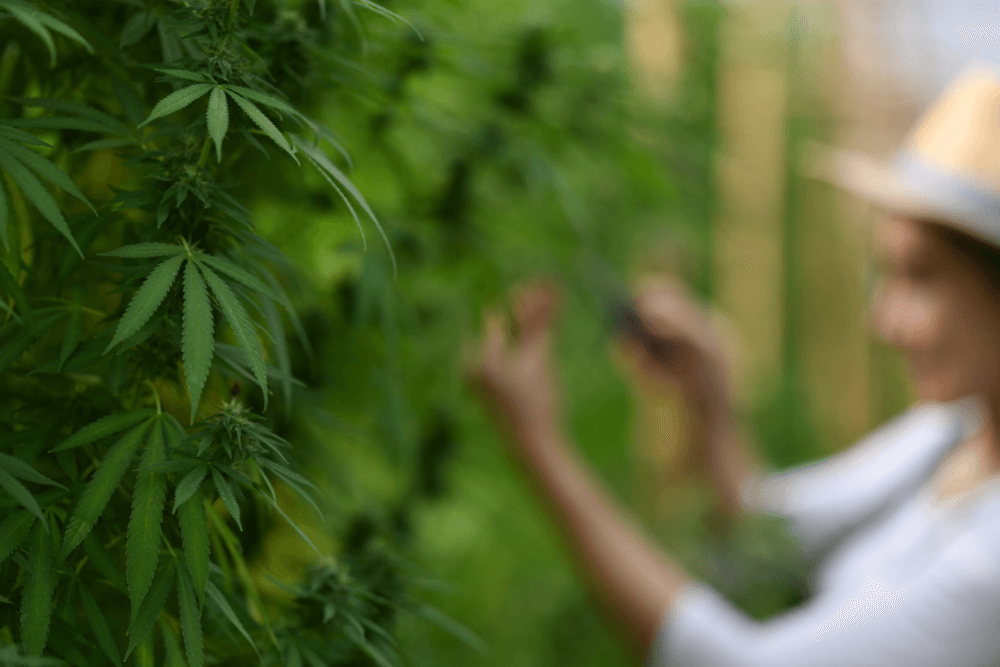
Earlier this year, Cannabis NewsHub reached out to successful female leaders in the cannabis community. We asked them to share insights and advice for aspiring industry professionals.
Overwhelming Success of the Social Media Campaign
Participation in this social media campaign was an overwhelming success, with more than 50 women in cannabis leadership sharing their “words of advice,” all of which were posted and shared through social media channels. See all posts on the Cannabis NewsHub website here.
Celebrating Diversity in Cannabis Leadership
The diversity of organizations was an affirmation that these women are truly “Thought Leaders” who represent cannabis in the following verticals: Advertising, Associations, Conference Development, Delivery Platforms, Dispensaries, Growers, Human Resources, Educators, Legal, Manufacturing, Marketing, Publishers, Software, and Tourism. This cross-section of verticals within the cannabis space validates the diversity of women and their roles in the industry. Their powerful advice serves as an education on how to succeed and find your path in this dynamic, ever-changing industry.
Shout-Out to Participating NCIA Members
We are proud to highlight some of the NCIA members who participated in the “Cannabis NewsHub – 2024 INSIGHTS Matter: Women in Cannabis Weigh In” campaign. These leaders are making significant contributions to the cannabis industry:
Thanks to all who participated, as well as to our friends and partners who helped to promote this campaign: BudsFeed, National Cannabis Industry Association (NCIA), the Cannabis Bar Association (INCBA), and the Association of International Certified Public Accountants (AICPA), who helped us find some of these amazing women.
For more information on Cannabis NewsHub or to be a part of our summer series, “INSIGHTS Matter: 280E”, please contact Nicole Montenegro, Marketing Manager, at nmontenegro@newsbank.com.or complete this form to participate directly.
Unlock Exclusive Savings with NCIA Membership
As a valued member of the National Cannabis Industry Association (NCIA), you can enjoy exclusive discounts on various industry services, including special offers from Cannabis NewsHub. This member benefit is designed to help you save while staying informed and connected in the cannabis industry.
Click here to learn more about the Cannabis NewsHub NCIA Member Special Offer.
Join NCIA Today to Access Member-Exclusive Benefits
Not yet a member? Now is the perfect time to join NCIA and unlock these incredible savings! As an NCIA member, you’ll gain access to a wide range of benefits, including:
- Discounts on industry services and products
- Networking opportunities with industry leaders and peers
- Educational resources to keep you updated on industry trends and best practices
- Advocacy support to help shape the future of the cannabis industry
Join NCIA today and take advantage of these member-exclusive discounts and many other benefits. Become a member now and start saving!
Committee Blog: Data-Driven Cultivation
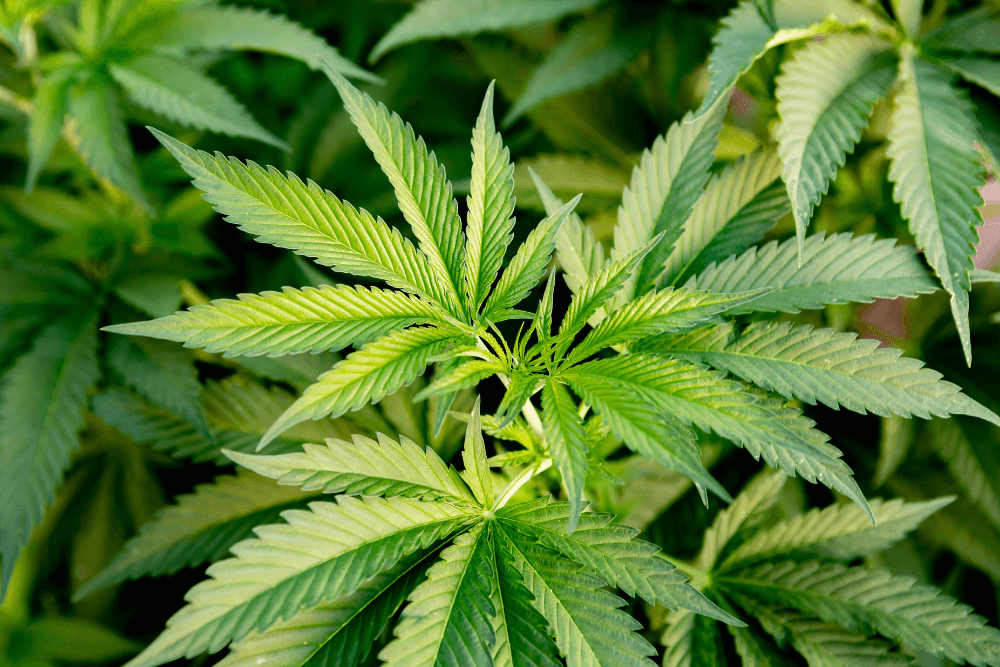
Published by Elmar Mair, PhD on behalf of NCIA’s Cannabis Cultivation Committee
In any industry, whenever we try to optimize a process, the first step is to collect data to understand the dependencies and identify bottlenecks. In cultivation, we are still lagging behind, and we accept an average process loss of 10-20%. How can we change that?
Cannabis cultivators will lead this transformation in cultivation
Cultivating and growing plants to their full potential takes experience and specialized skills. Cannabis is no different, and many would argue, can be even more difficult to grow compared to other plants; that is because cannabis is cultivated for multiple reasons. The majority of people know that cannabis is grown for recreational and medicinal use. However, cannabis is also grown for its hemp fiber to create paper, clothing, biofuel, and food. Cannabis is an extremely fast-growing plant. The plant attracts and is susceptible to many pests, including several types of insects, fungus, and bacteria. Another challenge with cannabis is the fact that it has not been grown at scale or studied to the extent of other crops. The legal cannabis industry has only been around since 2012, when Colorado and Washington were the first states to legalize recreational use. Growing cannabis is basically like driving a race car for the first time without knowing the course ahead. Good luck. Wouldn’t you want to know more about your race car, your team, and the uniqueness of the track in order to navigate with precision and skill? That’s exactly why data is such a powerful asset in cultivation, especially for cannabis cultivators.
Switch from qualitative to quantitative data
A lot of stress, miscommunication, and conflict in cultivation operations are due to the subjective nature of data collection. We rely on humans to assess a crop’s state and remember it when comparing historic results. “It looks better than last time.” or “It looks good.” – imagine if you could rely on numbers when making such statements: “We have 10% larger flowers than last cycle” or “This cultivar stretched until day 25 compared to the other cultivar which stopped stretching around day 30”. These are statements that are easy to agree on and hard to challenge since they are objective facts.
Capture a comprehensive set of data
The other important aspect to know about data is that data becomes exponentially more valuable the more complete and comprehensive it is. If you are baking bread and you only measure the flour but not the salt, water, or yeast, there is not much value to this information. The question we need to answer is what data allows us to draw a comprehensive picture of a garden. What data do you need to remotely steer a crop and guide a team on the ground? Cultivators heavily rely on the visual feedback of plants when assessing plant health. Being able to see the plants will be key but also to get a sense of plant health in numbers to allow for quantitative comparisons. Obviously, measuring environmental parameters like air temperature, relative humidity, light intensity, and CO2 is key to operating a cultivation facility. One of the most critical parameters to optimize is the Leaf Vapor Pressure Deficit or Leaf VPD. It provides information on how the plant is transpiring and, thus, how efficiently it can grow. In order to calculate the Leaf VPD, one also needs to know the leaf temperature. Substrate properties are another key piece of the cultivation puzzle. Water content, EC, and pH are important factors to navigate. Finally, it is important to know if any pests, molds, fungus, or viruses are present in the environment. And other factors are obviously key to measuring and understanding when operating a cultivation facility, like airflow, power consumption, etc. The more data you can capture the better you can consistently bake and optimize your favorite bread.
Leverage automation and AI to capture and process the data
However, when collecting data we need to keep in mind that all environmental parameters affect the same plant and, thus, they are all intertwined – in general, changing one parameter requires the adjustment of all other parameters as well. At the same time, the impact of these decisions is often only assessed by looking at the final yield, which makes it impossible to derive what influence each decision had on the respective result. Like in many other fields, modern automation and artificial intelligence are fueling the transition to data-driven decision-making in cultivation. And Cannabis, as one of the highest margin crops, is at the forefront of this evolution. Automated, intelligent systems can monitor your crop 24/7, allowing you to focus on fixing the issues rather than identifying them. They can measure properties across the full canopy, which have not been accessible before, like leaf temperature, bud count, plant stress, pests, and other crucial factors. They enable your team to assess the garden and to discuss its state remotely as well as to compare historic data across growth cycles.
Investing in data collection means making more money
The lack of data obviously results in inconsistencies and even crop loss—in cannabis, the industry average is 15% crop loss. Translation: millions of dollars lost, which goes even higher the larger the facility. That’s a significant amount of revenue that is lost instead of being deployed in other areas for expansion or optimization. In a highly competitive industry, implementing features such as data collection to minimize crop loss and optimize yield pays off quickly and can play a huge factor in a business’s long-term success.
Committee Blog: Discovering the Potency of Data – How Cannabis Brands Can Harness Audience Insights to Elevate Success

In the rapidly evolving landscape of the cannabis industry, understanding your audience is critical to staying ahead of the curve. For brands, this can be difficult given retailers hold the keys to their customer data. However, through the utilization of digital marketing, cannabis brands have the opportunity to glean invaluable insights from their audience data. In this comprehensive breakdown, we’ll explore how cannabis brands can leverage audience data from programmatic advertising, email campaigns, SEO and more to gain a deeper understanding of their customers and enhance their overall success.
The Power of Data in the Cannabis Industry
Data is the cornerstone of informed decision-making, and in the cannabis industry, with its regulatory restrictions and shifting consumer preferences, its importance cannot be overstated. By harnessing audience data from digital marketing campaigns, cannabis brands can move beyond conjecture and gain actionable insights into their customers’ behaviors, preferences, and needs.
Analyzing Audience Demographics
One of the primary benefits of digital marketing is the ability to gather detailed demographic information about your audience. Through tools like Google Analytics, social media insights, campaign reports, and customer relationship management (CRM) platforms, cannabis brands can paint a vivid picture of their customer base. From age and gender to location and interests, this demographic data provides invaluable insights into who your customers are and how best to engage with them.
Understanding Consumer Behavior
Beyond demographic data, digital marketing campaigns offer a window into consumer behavior. By tracking website traffic, engagement metrics, and conversion rates, cannabis brands can gain a deeper understanding of how customers interact with their brand online. This insight allows brands to identify trends, uncover pain points, and optimize their digital presence to better meet the needs of their audience.
Personalizing the Customer Experience
One of the most powerful applications of audience data is in personalizing the customer experience. By segmenting their audience based on demographic information, cannabis brands can tailor their messaging and offerings to resonate with individual customers. Whether through targeted email campaigns, customized product recommendations, or educational content, this level of personalization not only enhances the customer experience but also drives engagement and loyalty.
Optimizing Marketing Strategies
Audience data also serves as a compass for guiding marketing strategies in the cannabis industry. By analyzing the performance of various marketing channels, content types, and messaging approaches, brands can identify what resonates most with their audience and allocate resources accordingly. Whether it’s investing more heavily in content creation, refining digital advertising tactics, or experimenting with email campaigns, data-driven insights enable brands to optimize their marketing efforts for maximum impact.
Predicting Trends and Forecasting Demand
In addition to informing day-to-day marketing decisions, audience data can also provide valuable insights into larger industry trends and consumer preferences. By analyzing macro-level data trends across their customer base, cannabis brands can identify emerging market opportunities, anticipate shifts in demand, and stay ahead of the curve. Whether it’s launching new product lines, expanding into new geographic areas, or pivoting to meet evolving consumer needs, data-driven forecasting empowers brands to make informed strategic decisions.
Enhancing Product Development
Finally, audience data can play a pivotal role in shaping product development strategies within the cannabis industry. By soliciting feedback from customers through surveys, reviews, and social media interactions, brands can gain valuable insights into product satisfaction, preferences, and needs. This feedback loop not only informs the development of new products but also enables brands to refine existing offerings based on real-time customer input, ensuring that their products remain relevant and competitive in a rapidly evolving market.
Conclusion
In conclusion, audience data is a potent asset for cannabis brands seeking to unlock the full potential of their marketing efforts. By analyzing demographic information, understanding consumer behavior, personalizing the customer experience, optimizing marketing strategies, predicting trends, and enhancing product development, brands can gain a deeper understanding of their customers and elevate their overall success in the cannabis industry. As digital marketing opportunities continue to evolve, brands that harness the power of data will undoubtedly emerge as leaders in this dynamic and rapidly growing market.
Member Blog: Colorado’s Evolving Cannabis Testing Regulations


Among the first two states to legalize and the first market to open, Colorado has had adult-use cannabis regulations in place for more than a decade now and helped set a standard for all the programs that came after it.
But Colorado’s testing regiment, like the industry, is ever evolving, with the state testing for additional pesticides beginning this year, for example. In addition, the state’s new “reduced testing allowance” could make the whole process easier for manufacturers in good standing.
Like many states, Colorado requires testing of the final product, be it flower, edible or pre-roll, which means not only must your flower be clean, but everything else you put into your products as well. In the case of pre-rolls, that means the paper used in the pre-rolled cones, as well as the filter tip.
All products must be screened by a state-licensed and accredited laboratory for the following:
- Moisture Content and water activity;
- Residual solvents and processing chemicals;
- Residual pesticides;
- Microbial impurities;
- Mycotoxins;
- Foreign materials;
- The “big four” heavy metals (arsenic, cadmium, lead and mercury); and
- Cannabinoid potency.
WATER ACTIVITY
Like every state, Colorado testing requires laboratories check for water activity because high amounts of moisture can create an environment with the potential for mold growth.
Any water activity above 0.70 Aw creates the conditions for mold to grow, which can be harmful if consumed, which is why Colorado caps water activity at 0.65 Aw in flower and pre-rolls.
PESTICIDES AND SOLVENTS
Colorado also requires testing for residual pesticides and other chemicals and has been slowly ramping up its required pesticide testing.
For example, on January 1, 2023, the state tested for a total of 13 different pesticides. By July 1, 2023, that number had increased to 28. But new regulations going into effect this year drastically increase that number.
Beginning July 1, 2024, state law requires labs to test cannabis products, including completed pre-rolls, for 99 different pesticides, each with their own actionable limits that can cause a whole batch to be destroyed.
Additionally, the state requires cannabis concentrate products, including those used in infused pre-rolls that combine flower with a concentrate for increased potency and flavor, to be tested for residual solvents.
The state requires testing and provides actionable limits for 13 specific solvents that can be used to make extracts and concentrates, as well as requiring “none detected” for “any other solvent not permitted for use.”
HEAVY METALS
The Centennial State also requires testing for the heavy metals mercury, cadmium, lead and arsenic. All four metals are toxic to humans, even at small doses, and can damage all the body’s vital systems, including pulmonary, reproductive and even the central nervous system.
Testing for heavy metals is especially important because cannabis plants are a well-known bio-accumulator that absorbs and collects heavy metals from the soil in which it grows.
For all inhalable products, including pre-rolls, the state sets the pass/fail actionable level at 1.5 parts per million (PPM) for mercury and arsenic, 0.5 PPM for cadmium and 1 PPM for lead.
MICROBIALS AND MYCOTOXINS
But while heavy metals are dangerous, they do not pose the greatest risk to human health among the testing. That distinction is reserved for microbials and mycotoxins.
Among the microbes – bacteria and fungus – for which Colorado requires testing are salmonella, Staphylococcus aureus and e coli. There is also a total yeast and mold limit.
Mycotoxins are a toxic compound produced by molds, such as Aspergillus, and can suppress the immune system and cause liver damage. Testing for mycotoxins help ensure cannabis products are safe for human consumption.
Colorado requires testing for two classes of mycotoxins, Aflatoxins and Ochratoxin A, each with an actionable limit of 20 PPM. Both have properties that can alter DNA and potentially cause the formation of cancer cells.
PRE-ROLL TESTING
But it’s not just the flower that needs to be tested in Colorado. Products must be tested in their final form, which means that pre-rolls, for example, must be tested after they have been packed, so the paper has to be as clean as the flower. And with no regulations or requirements on the testing of rolling papers themselves, several manufacturers have run afoul of the rules because of untested rolling papers or wraps. And testing by SC Labs, one of California’s licensed testing labs, found that 11% of rolling papers tested during a recent study would fail testing. So even if you are packing your own pre-rolls, it’s important to make sure the paper you choose is tested and clean.
Colorado has also had issues with this in the past, particularly in palm leaf wraps and blunts. In 2022, the states Marijuana Enforcement Division issued a recall for King Palm products due to unsafe mold and yeast levels found in the products.
“Take due diligence to make sure your product is viable,” says Custom Cones USA Compliance Manager André Bayard, noting that manufacturers should work with suppliers that are working to set industry standards. “Any one issue can be detrimental to your brand reputation.”
REDUCED TESTING ALLOWANCE
Recognizing the unique challenges and cost of testing, Colorado has introduced new reduced testing allowances, including one tailored for pre-roll cannabis products. This allowance enables cannabis manufacturers to submit composite samples for testing, rather than subjecting each individual batch of pre-rolls to separate testing.
For example, a manufacturer may achieve a Reduced Testing Allowance for contaminant testing for a specific product, like pre-rolls, if every production batch that it produced during at least a four- to eight-week period passed all contaminant tests. However, if those pre rolls are produced using different input materials, such as a different cannabis category (e.g. flower or trim), different wrapper materials, different processes or different equipment, they must get a separate Reduced Testing Allowance.
Additionally, effective July 1, 2024, to achieve or maintain a Reduced Testing Allowance for microbial contaminants, a cultivation facility must have a Hazard Analysis and Critical Control Point (HACCP) System in place. An HACCP must contain elements defined in ASTM D8250-19: “Standard Practice for Applying a Hazard Analysis Critical Control Points (HACCP) System for Cannabis Consumable Products” that addresses each product type for which a microbial contaminant Reduced Testing Allowance is sought.
It’s important to highlight that not all cannabis products qualify for this reduced testing allowance, and pre-roll manufacturers must meet specific criteria to be eligible for this exemption. For example, to get a reduced testing allowance for microbial testing, a company must maintain cleaning records and maintenance records.
Reduced testing allowances are valid for one year.
It’s a complicated program to be a part of, but well worth it for manufacturers who have their procedures locked in, as well as a supplier that also tests their pre-rolled cones and tubes to the highest standards to ensure passage of these important tests.
FINAL THOUGHTS
Colorado’s pre-roll cannabis testing regulations play a vital role in safeguarding public health and ensuring consumer confidence in the state’s legal cannabis industry. And from a business standpoint, a testing failure can be costly, especially for smaller businesses, and can follow a company and its products even after the issue is corrected.
Make sure your suppliers take the same care as you do to ensure passage of all required tests. And always ask for COAs.
Member Blog: Creating Cohesive Cannabis Teams – How AI-Driven Hiring Promotes Diversity and Innovation

Creating cohesive teams in the rapidly growing cannabis industry involves overcoming unique recruitment and hiring challenges, including evolving regulatory landscapes and societal misconceptions. The shift from traditional recruitment methods to innovative, AI-driven approaches marks a fundamental transformation in how companies identify, evaluate, and onboard talent, promising a more efficient, equitable, and effective hiring process.
Traditionally, the cannabis industry, like many others, relied on posting job openings on industry-specific job boards, sifting through resumes, conducting face-to-face interviews, and relying on gut instincts. These methods, while having their merits, come with significant limitations, especially in an industry as specialized and fast-paced as cannabis. The reliance on subjective assessments and the potential for bias, along with the inefficiency and high risk of overlooking culturally fit candidates, highlight the need for a new approach.
The adoption of AI-driven recruitment strategies represents a significant leap forward. Platforms leveraging advanced technologies can streamline the hiring process and enhance the quality of matches between employers and candidates. For instance, AI platforms such as jobworX ai, can analyze vast amounts of data quickly and accurately, evaluating candidates across various workplace personality factors, and providing employers with actionable insights into candidate capabilities, personality traits, and potential cultural fit. These insights are crucial for aligning recruitment choices with organizational goals and the unique demands of roles within the cannabis industry. For instance, predictive analytics can forecast a candidate’s success in a particular role, while natural language processing (NLP) and machine learning (ML) enhance the efficiency of sifting through applications, identifying top talent based on predefined criteria This comprehensive approach allows for a more nuanced understanding of each candidate’s potential fit within a given role and organizational culture, addressing the unique challenges of the cannabis sector.
AI-driven recruitment strategies reduce reliance on subjective judgments, mitigate the risk of bias, and expedite the selection process. By focusing on personality traits and cultural fit alongside technical qualifications, these platforms enhance job satisfaction and retention rates. This holistic approach is invaluable in the cannabis industry, where adaptability and alignment with the company’s mission are crucial.
Moreover, AI tools facilitate a deeper understanding of market trends and candidate expectations, allowing cannabis companies to adapt their hiring strategies in real-time. This adaptability is essential in a sector where regulatory landscapes and consumer preferences constantly shift. By harnessing the power of AI, cannabis employers can navigate these complexities with confidence, ensuring their teams are not only compliant but also diverse, innovative, and aligned with the company’s mission and values. In essence, AI transforms data into strategic decision-making power, setting the stage for sustainable growth and competitive advantage in the cannabis industry.
Navigating regulatory frameworks and societal misconceptions is a significant challenge in the cannabis industry. AI tools can help businesses make hiring decisions that are compliant, fair, and unbiased. By automating and streamlining the vetting process, AI ensures that all applicants are evaluated against the same legal standards, reducing the risk of non-compliance.
Looking toward the future, several key predictions and trends emerge, highlighting how AI technologies will continue to revolutionize hiring in the cannabis industry. Predictive candidate matching, an enhanced focus on cultural and personality fit, streamlined and efficient hiring processes, increased accessibility and equity in hiring, and data-driven insights for continuous improvement are all trends shaped by AI integration. These advancements promise to reshape the landscape of recruitment and talent acquisition, making the process more efficient, equitable, and effective.
Building cohesive teams and maintaining a strong organizational culture is crucial for success. AI-driven recruitment tools, such as jobworX.ai, are revolutionizing the way companies approach this challenge by focusing on matching candidates with roles that align with their personalities and values. Kristina Etter, a freelance writer and journalist based in Colorado, highlighted in her article, Cannabis Hiring 2.0: jobworX ai’s Game-Changing New Approach, the innovative approach to recruitment within the cannabis industry via jobworX.ai, employing a Personality Assessment tool to match job seekers’ personality traits with the specific needs of cannabis roles. This method boosts job fit, worker satisfaction, and organizational synergy. It highlights the transformative role of AI in modernizing hiring practices by leveraging AI and personality assessments to ensure that candidates are not only technically skilled but also culturally and personally compatible, marking a significant advancement towards more streamlined and harmonious recruitment processes in the cannabis sector.
By leveraging advanced AI algorithms and comprehensive personality assessments, these platforms provide a data-driven approach to identifying candidates who not only possess the necessary skills but also fit seamlessly into the company’s culture. This emphasis on cultural fit is particularly important in the cannabis industry, where passion, innovation, and adaptability are key drivers of success.
AI-driven tools analyze candidates’ workplace personality traits, such as teamwork, leadership, and interpersonal dynamics, to determine their potential for contributing to a positive and collaborative work environment. By prioritizing these factors alongside technical qualifications, companies can build harmonious teams that foster a sense of shared purpose and drive organizational growth.
Moreover, by streamlining the recruitment process and reducing the risk of bias, AI-driven platforms help create a more diverse and inclusive workplace. This diversity of thought and experience is essential for driving innovation and navigating the unique challenges of the cannabis industry.
In conclusion, the integration of AI-driven hiring strategies within the cannabis industry marks a pivotal evolution in how companies approach talent recruitment and onboarding. By moving beyond traditional recruitment methods and embracing AI’s capabilities, the industry is set to revolutionize the way it builds teams, fostering environments that are not only more cohesive but also rich in diversity and innovation.
AI-driven tools offer a more nuanced and comprehensive evaluation of candidates, analyzing a wide range of workplace personality traits to ensure potential hires will contribute positively to a collaborative and innovative work environment. This focus on creating teams that share a sense of purpose is essential for driving organizational growth and maintaining a strong organizational culture amidst the rapid changes and regulatory complexities of the cannabis industry.
The advancements in AI-driven recruitment, including predictive candidate matching, a focus on cultural and personality fit, streamlined hiring processes, and data-driven insights, are set to make the hiring process more efficient, equitable, and effective. As the cannabis industry continues to grow and evolve, integrating AI into hiring practices will be instrumental in building adaptable, innovative teams capable of overcoming the sector’s challenges and seizing its opportunities.
In essence, the future of hiring in the cannabis industry, shaped by AI integration, is bright. It offers the promise of a more strategic, data-informed approach to recruitment that aligns with organizational goals, fosters diversity and innovation, and sets the stage for sustainable growth and competitive advantage. As companies navigate the complexities of the cannabis market, AI-driven hiring strategies will undoubtedly become a cornerstone of successful talent acquisition and management, ensuring that the industry remains at the forefront of change and innovation.
Member Blog: How to Build a Sustainable Cannabis Packaging Solution

According to NielsenIQ, 92% of consumers say sustainability is important when choosing a brand today. Packaging can play a significant role in helping brands meet their sustainability goals and attract eco-conscious consumers. Designing and manufacturing sustainable packaging requires a holistic approach that includes understanding the actual container, the manufacturing process, transportation and energy requirements, carbon footprint, and government regulations. When it comes to the cannabis industry, packaging solutions must also meet requirements around child resistance, tamper-evidence, opacity, resealability, label design, and more. Despite the complexities, sustainable cannabis packaging can be compliant, functional, and beautiful. Cannabis brands have many eco-friendly pathways to consider.
Compostable
Compostable packaging refers to packaging that will decompose into nutrient-rich organic matter, CO2, and water in a controlled environment in the home or commercial composting facility. According to the U.S. Composting Council, compost diverts waste from ending up in landfills, conserves water, improves soil health, promotes plant growth, and combats climate change. Because of their organic composition, cannabis products are an emerging application for compostable packaging made from hemp and other plant-based materials. Compostable products must meet strict testing requirements for decomposition, such as specific environment, specific time frame, environmental toxicity, etc. Compostable should not be confused with biodegradable packaging, which has no such requirements and may contribute to greenwashing. Compostable packaging solutions are available for cannabis products, including pre-rolls, flower, and edibles.

Recycled Materials
Beyond using recyclable packaging, today’s brands are increasingly using recycled materials like post-consumer recycled (PCR) plastics, ocean-bound plastics, and recycled paperboard to demonstrate a commitment to the environment. Post-consumer recycled content in packaging contributes to a circular economy by extending material life cycles. According to the US Plastic Pact, it reduces landfill waste, conserves natural resources, saves energy, and lowers greenhouse gas emissions. Adding PCR content to packaging decreases its carbon footprint (reduced energy use, greenhouse gas emissions, extraction of finite natural resources, and landfill disposal) compared to using 100% virgin materials, helping brands meet their sustainability goals. In addition to consumer demand, government regulations are also driving the use of PCR materials. New York introduced requirements for PCR plastic use in cannabis packaging. The Marijuana Regulation & Taxation Act (MRTA) states, “cannabis product packaging cannot be made of any plastic, unless that plastic contains a minimum 25% post-consumer recycled content.”
Reusability
Reusable shopping bags, refillable water bottles, and metal drinking straws are just a few reuse initiatives people have worked into their everyday routines over the past several years. Reusability reduces single-use packaging waste and promotes a circular economy. Consumer packaged goods brand owners – including those in the cannabis industry – are beginning to capitalize on the growing refill and reuse mentality by introducing reusable packaging. Reusable cannabis packaging can be refilled with more cannabis or used for other purposes. Material selection is essential to ensure reusability is practical and sustainable. Glass containers and high-quality, durable plastics are long-lasting and well-suited for reuse. Food-safe packaging solutions provide added functionality and additional usage occasions. Dockside Cannabis dispensaries feature seven ways to repurpose old cannabis containers.

Paper, Inks & Labeling
Secondary packaging, label components, and decoration can also play a role in a brand’s sustainability story. Using Forestry Stewardship Council (FSC) certified paper for shipping cases, secondary cartons, and inserts helps protect healthy, resilient forests. Several cannabis brands use FSC paper for their rolling papers. Inks may not be top of mind when considering eco-friendly packaging, but even seemingly minor details can have a significant impact. Inks, dyes, and coatings can inhibit recyclability and/or reusability, so using soy-based, water-based, or vegetable-based inks contributes to the lifecycle of a package. Soulshine Cannabis uses paper sourced from sustainable PNW forests and prints with vegetable-based inks as part of its commitment to be an environmentally conscious cannabis company.
Shipping Efficiencies
For a packaging solution to be truly sustainable, it needs to perform at every stage of its journey, from the warehouse to the consumer. Shipping is a big part of a package’s journey and an important part of its carbon footprint. According to the EPA, greenhouse gas (GHG) emissions from transportation account for about 29% of total U.S. greenhouse gas emissions. When it comes to transportation – and cannabis – size matters. Sizing is an essential factor when selecting the proper cannabis packaging, as it can impact the quality of the product. However, right-sizing your package to ensure it’s not larger than it needs to be can reduce the environmental impacts of shipping. Light-weighting – reducing the weight of your package by rethinking the size, material, or unneeded components – can also make a difference. Efficient packaging can reduce fuel consumption and emissions associated with shipping.
When it comes to sustainable cannabis packaging, there is no one-size-fits-all solution. Brands should consider a variety of tactics including material, size, weight, decoration, and more to find the most effective and impactful package for their product.
Member Blog: Amazon’s “Hemp” Products Are Lying to You, New CBD Oracle Lab Study Finds

Amazon’s “Hemp” Products Are Lying to You (and Hurting the Industry), New CBD Oracle Lab Study Finds
TL;DR: A CBD Oracle investigation finds that 43% of hemp products sold on Amazon often don’t contain hemp at all, and are deceptively marketed to evade Amazon’s lax enforcement.
The independent investigation of the hemp market on Amazon which was commissioned by CBD Oracle has found that almost half of all products lie to customers and has revealed the challenges faced by both consumers and honest sellers on the platform.
Along with 43% of so-called “hemp” products not containing any hemp at all, companies selling on Amazon.com often report their products being pulled from the storefront while those obviously lying about their contents remain up on sale.
The market is a minefield for consumers and the main benefactors are deceptive fly-by-night companies and Amazon themselves.
A Brief Introduction to Amazon’s Hemp
If you’ve ever bought or sold hemp before, browsing the selection available on Amazon is truly bewildering.
Products promise doses of hemp that are impossible to fit into a gummy, make obvious medical claims and reassure customers that they’re third-party lab tested while usually not making the results available on Amazon or anywhere else. There are so many red flags they start to look like wallpaper.
Amazon policy prohibits CBD unless it’s a topical product which has been specifically approved. This was established to prevent unreliable or illegal products from making it onto the site, but the consequence has been just the opposite. Instead, sellers simply don’t mention the word “CBD” anywhere on the product page, and this provides a smoke-screen to companies hoping to sell the expectation of CBD while actually offering nothing of the sort.
“Hemp” on Amazon is not a description, but a purposefully vague euphemism.
Testing the Hemp Sold on Amazon
CBD Oracle purchased 56 of the most popular hemp products on Amazon and sent them to InfiniteCAL for testing. The main results show the impact of the current policies on the platform.
- 30% of products contained CBD. Although these products violate Amazon policy, they at least offer customers what the listings imply in a basic sense.
- 62.5% of products contained no cannabinoids at all. Given that the majority of products explicitly promised some amount of “hemp” in milligrams, these products are misleading at best.
- 43% of products contained no hemp at all, as verified by gas chromatography-mass spectrometry (GC-MS) testing. Every single product in the study promised “hemp,” but even if they meant hemp seed oil, these 43% are still blatantly deceiving customers.
- 11% of products tested positive for THC, with three products having huge quantities of delta-8 THC. The maximum dose per gummy was 76 mg THC.
- 96% of products did not provide an accurate dosage to customers. This means that the measured dosage doesn’t fall within 10% of what they advertised.
The Misleading Marketing of Amazon’s Hemp
The lab results show that the hemp sold on Amazon doesn’t meet the expected standard of CBD and hemp products in the modern day. However, customers on Amazon are less likely to be engaged with the industry and probably have less of an idea of what is expected of any hemp product. Combined with some careful marketing, this makes the average Amazon hemp buyer way more likely to pick up an unreliable product.
CBD Oracle’s analysis of the marketing of Amazon hemp reveals many serious problems with the market and the claims sellers make:
- 52% of products are sold based on unapproved medical claims, often surrounding pain, stress or anxiety relief.
- 95% of products do not provide a third-party lab report to consumers anywhere online, and none of them are shown on Amazon.
- Customer reviews were unreliable in about half of cases. Mozilla’s FakeSpot rated 48% of products D or lower for overall reliability.
- There was no reliable, direct method to communicate with the sellers behind 89% of products. 28 products were identified as breaking the INFORM Consumers Act.
- Many products make claims which are literally impossible (e.g. 7.7 pounds of “hemp” in a 0.8 pound package), but are not removed when reported to Amazon.
How Amazon’s Hemp Impacts the Wider Industry
Amazon’s hemp market is not only bad for the customers who choose to make purchases through the retailer; it also threatens the perception of the industry at large.
Andrew Livingston, Director of Economics & Research at Vicente, commented to CBD Oracle that:
“One, these products drive consumer[s] away from the entire hemp supplement category for fear that the entire market cannot be trusted or is not properly regulated. This means legitimate businesses with great products that benefit consumers lose out. Second, problematically labeled and branded hemp products indicate to regulators and public officials that the entire category needs more robust and stringent restrictions.”
In short, even though these products come from unknown companies and aren’t widely regarded in the hemp industry, their careless actions threaten to drag the whole industry through the mud with them.
Conclusion: How Amazon Can Solve the Problem
Amazon’s hemp problem is created by a lack of enforcement and a policy which incentivizes companies that lie about their products. In line with this, there are two avenues for a solution.
Firstly, Amazon could simply devote more resources to enforcing their current policy.
Alternatively, and more realistically, they could acknowledge that CBD is sold on their platform, and instead rectify their policy. By allowing CBD products if they are backed up with a certificate of analysis by an accredited third-party lab, honest manufacturers would be able to compete on a level playing field, and virtually all of the products in this analysis would have to prove their claims or be removed from sale.
One thing is certain: the status quo on Amazon is harmful to both consumers and the industry, and it has to stop.
The full dataset from the analysis is available in this spreadsheet. You can download a summary of the report in PDF here.
About the author:
Lee Johnson is the senior editor at CBD Oracle, and has been covering science, vaping and cannabis for over a decade. He focuses on research-driven deep dives into topics ranging from medical uses for CBD to industry and user statistics, as well as general guides and explainers for consumers.
CBD Oracle is a consumer research company working to improve the safety and transparency of cannabis and hemp products, producing in-depth research pieces on cannabis and cannabinoids, along with analysis of social and legal issues.
Member Blog: How to Hire a Fractional Cannabis CFO

Small businesses — from startup to $20 million — face challenges when it comes to hiring accounting and finance staff.
In addition to the budget-breaking cost of an in-house finance team, it’s not easy to find, train and manage the right people within the day-to-day of a growing business. Not to mention the fact that a full-time team likely wouldn’t have enough work to keep themselves busy with a business of that size. That’s why outsourcing has become popular across industries: small businesses can leverage the expertise of bookkeepers, tax preparers and planners, as well as CPAs and financial advisors, at a fraction of the cost.
The advisory role — often referred to as outsourced or fractional CFO services — fills a particularly essential need, providing business owners with a strategic partner to help make financial decisions about their short-, medium- and long-term future at a lower price-point than a full-time Chief Financial officer (which averages $229,000 per year not including vacations, bonuses and other benefits).
That’s why businesses between the $3-$20-million revenue mark consider outsourcing the position. Oftentimes these services include a la carte options such as taxes, accounting, payroll, and coding of transactions (essentially bookkeeping), depending on whether the business already has some of these functions in-house.
Three things to look for when hiring a cannabis CFO
There are a variety of ways to access outsourced or fractional financial services, whether it’s hiring an individual, using a freelance match-making service or working with a dedicated team.
- Do they provide forward-looking advice?Cannabis companies face unique challenges. Every business could benefit from cash flow forecasting, but in cannabis, where profits are extra tight, a CFO needs to be able to help strategic planning: weighing the cost-benefit of investments, strategizing to manage overhead and boost sales, and ensure the business stays disciplined as it grows.
- Are they involved in the industry?In an industry like cannabis, where regulatory shifts are always on the horizon, you want a CFO is staying on top of policy — both federal and local. That means they’ll have the necessary insight to help you plan with those changes in mind, as well as to think about what could happen as a result of all these shifts within your business.Beyond policy, a CFO should be able to help businesses with other industry-specific challenges, like securing merchant services for dispensaries and establishing banking relationships, which is significantly tougher for cannabis businesses to do, in light of current federal policy.
- Do they ask strategic questions?A good CFO never tells you what to do. They get to know your business through in-depth questions, identify the non-financial drivers to monitor and improve, and then help you navigate the best path with the information that you have.
When is it time to hire a fractional cannabis CFO?
If you find your business is getting to a point where you’re making decisions but don’t understand the financial impact or don’t know what risks may be out there — especially if you’re in a growth phase — hiring a fractional CFO will help guide you on the financial side and still fit within your budget.
The cannabis industry is at an inflection point. There are so many areas where strategic planning isn’t a nice-to-have, it’s a must-have. As regulations shift, it will be essential to have a financial partner who can help businesses pivot quickly and adopt new technologies that become available to the industry as we move forward with policy progress at the federal level.












































